| **Waypoint** | **Restriction** | **Climb** |
|---|---|---|
| **COL** *Cola* | -- | climb via |
| **DODEN** | min. RFL 260 flights unable for climb restrictions (see charts) shall refile via KUMIK | climb via |
| **GMH** *Germinghausen* | max. RFL 140 | climb |
| **KUMIK** | min. RFL 150 | climb via |
| **LMA** *Lima* | DEST EDLN only or local IFR flights | climb |
| **MEVEL** | -- | **23 Ops:** climb via **05 Ops:** climb |
| **MODRU** | min. RFL 210 | climb via |
| **NETEX** | Only available at night between 2200LT and 0600LT and during weekends and holidays due to military airspace in the north of the EBBU FIR. Information about the activation of the military areas can be obtained from the EBBU controller. | **\#U, #K:** climb via **all other:** climb |
| **NVO** *Nörvenich* | max. RFL 90 flights with RFL at or above FL100 shall refile via MODRU | climb |
| **NUDGO** | max. RFL 240 | climb |
| **SONEB** | -- | climb via |
Local departures need to be advised to contact **DLA** on 128.555 immediately after departure.
### Datalink Clearance (DCL/PDC) At Düsseldorf Airport we offer Datalink Clearance to the pilots via the **[Hoppie System](https://www.hoppie.nl/acars/ "Hoppie Datalink System")** and the Topsky Plugin. The airport code EDDL should be used (already preselected). An example of the DCL message the pilot will receive can be seen below. By default startup always needs to be approved separately.CLD 2042 220117 EDDL PDC 026 SAS461L CLRD TO EKCH OFF 23L VIA MEVEL3T CLIMB 5000 SQUAWK 2055 ADT MDI NEXT FREQ 121.780 ATIS H REPORT READY ON 121.780
### Startup When startup clearance cannot be given immediately or the pilot is not ready for startup within the next 5 minutes, the pilot needs to stay on Delivery frequency until they receive their startup clearance. **Runway Capacity: **To ensure smooth operations and an acceptable level of workload for following stations, **Delivery has to ensure an appropriate startup rate**. This can either be achieved by use of the **[vACDM plugin](https://knowledgebase.vatsim-germany.org/books/vacdm)**, or by adhering to a number of maximum startup clerances. Delivery should ensure that not too much outbounds in the same area receive startup at the same time.**Maximim active Startup Approvals** at the same time (status SUG until DEP) per active runway (use the vSID startup counter): **One active runway:** 10 **Two active runways:** 13
**Outbound Taxi Times:** The average time between startup approval and takeoff clearance is 10 - 15 minutes during 05 operations and 15 - 20 minutes during 23 operations. ### High Traffic at EDDK During high inbound peaks into Cologne with 13 operations, Cologne Approach may use the Düsseldorf Approach sector. Therefore traffic departing Düsseldorf out of runway 23L/R to the south (COL, DODEN, NUDGO, GMH, KUMIK, NVO) require a **startup release** by Düsseldorf Approach. In case of startup delays, it might be usefull to clear **outbounds to the south via MEVEL SID** and radar vectors to the filed first waypoint (no clearance via datalink for that). Additional coordination with APP required when this procedure should be used! > ... cleared XXXX via MEVEL4T, expect radar vectors to DODEN/KUMIK/NUDGO/COL/NVO, flight planned route... When the MEVEL SID is used, the flightplan need to be amended accordingly (e.g. "MEVEL DCT DODEN")**vSID:** Use the alias command "**.nosouth**<space><enter>" to disable the automatic vSID assignment for outbounds to the south. SIDs via "MEVEL DCT XXXXX" are highlighted.
# EDDL - Tower 2501 **Düsseldorf Tower** is responsible for all runways and the control zone (CTR), as well as Taxiways in between the parallel runways. ### Control Zone D-CTR of Düsseldorf reaches up to 2500ft AMSL. For details see VFR charts. [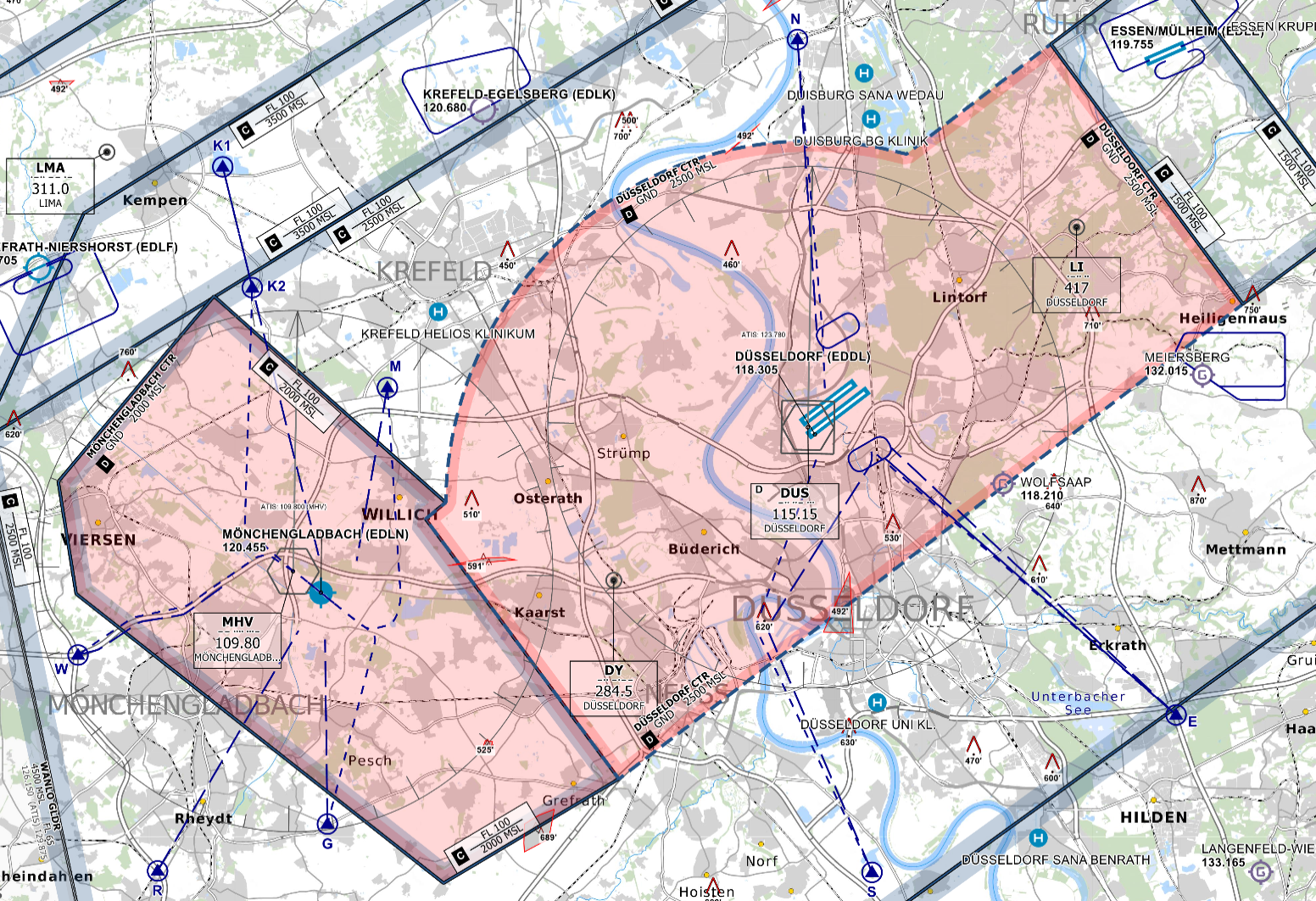](https://knowledgebase.vatsim-germany.org/uploads/images/gallery/2022-10/eddl-ctr.png)*Düsseldorf control zone (D-CTR) - © [openflightmaps.org](https://www.openflightmaps.org/)* Düsseldorf has three VFR mandatory reporting points (November, Sierra and Echo) that should be used for all VFR traffic leaving or entering the CTR. To the west, the Düsseldorf Tower Control Zone is directly adjacent to the Mönchengladbach CTR (EDLN), which extends from GND to 2000 ft AMSL with its own VFR reporting points. All VFR flights from one to the other CTR should be coordinated. C-Airspace is lowered to 2000 ft AMSL over the Mönchengladbach control zone. At the eastern border of the Dusseldorf control zone, the C airspace is lowered to 1500 ft AMSL due to the proximity to Essen-Mülheim Airport (EDLE). **VFR Traffic:** Northern traffic pattern is prefered for all VFR flights. Whenever possible VFR traffic should perform a long landing during 23 ops. **Helicopter:** Directly at the airport there is only one helipad in front of Hangar 10, in the far east, near the long-distance train station, which is used exclusively by the NRW police flight squadron (Hummel) and the federal police (Pirol). These helicopter are allowed to depart/land in front of the hangar and do not need to contact Delivery or Ground. All other helicopters need to use the runway for departure and landing. South of the control zone, approx. 3 NM north of SIERRA, is the Düsseldorf University Hospital (UKD). The rescue helicopter Christoph 9 (CHX9) is stationed close to the northern border, approx. 2.2 NM south-east of NOVEMBER, at the Berufsgenossenschaftliche Unfallklinik (BGU) Duisburg. Here, a request to fly through the tower control zone can often be expected during missions. Further information see [https://knowledgebase.vatsim-germany.org/books/practical-procedures/page/runway-change-guide](https://knowledgebase.vatsim-germany.org/books/practical-procedures/page/runway-change-guide). ### Runway Usage Düsseldorf Tower is responsible for the direction of operation. There is no preferred operating direction in Düsseldorf, so you should take a look at the METAR and TAF before making a decision so that you don't have to change runways at the traffic peak, especially during events. If a change is necessary, this should be coordinated with Approach in order to find a good time for the [runway change](https://knowledgebase.vatsim-germany.org/books/practical-procedures/page/runway-change-guide "runway change"). Primary only runway 23L/05R should be used for departures and landings. In high traffic situations runway 23R/05L should be used for landing and 23L/05R for departing traffic (VFR and IFR). **Heavy Traffic:** Runway **23R/05L** is **not** available for the A380! Inbounds always have to land on runway 23L/05R. If requested by the pilot, other heavy traffic (e.g. B747, MD11 etc.) shall also be given the oppertunity to land on 23L/05R, even during high traffic volumes. ### Arriving Traffic **Missed Approach:** For all published approaches, missed approaches will be executed as published, unless otherwise agreed. In the event of a missed approach, the responsible radar station must be informed (via Topsky or verbally). Any deviating action must be agreed in advance with the relevant approach controllers, except for actions by the Tower to reestablish seperation. In this case, the approach controller shall be informed immediately. The handover takes place once seperation is established. The next departure requires a departure release. **Seperation:** Düsseldorf Tower is responsible for maintaining separation, if necessary by use of adequate means (e.g. speed control), of arriving traffic from transfer of communication until touchdown and during the initial part of a missed approach. **Swingover:** Visual swingover (visual approach) from runway 23R to 23L is possible when traffic permitts. Therefore the pilot has to have the runway 23L in sight, before beeing cleared for the visual approach. With the clearance for the visual approach the pilot has to be given a new instruction how to continue in case of a **missed approach**. Therefore, runway track and a climb to 4000ft shall be used. **Runway Crossing:** Traffic landing on 05L/23R will have to cross runway 05R/23L, before being handed over to ground. Traffic vacating 23R via K3 shall cross the runway into either L7 and L6, depending on their assigned Gate and shall be handed over to either east or west Ground. This will reduce congestion around the Checkpoints and avoid unnecessary frequency changes. It is not allowed to vacate rwy 23L via L7 and turn left on M. **Vacating RWY 05R:** Traffic vacating RWY 05R via L1, L3 or L4 (after landing or crossing) are instructed by Tower to turn right on M and to hold short of the next intersection. The handoff to Ground will take place thereafter. This will prevent traffic to stop in the intersection and blocking the runway during frequency change. Traffic vacating runway 05R (or 05L via K1) are not permitted to taxi into L2. ### Departing Traffic **Seperation & Spacing:** All departures must be separated by at least 3 NM or wake turbulence separation, whichever is greater. During 23 Operations, care should be taken not to send them out at exactly 3 NM. As not all of them start their turn at the same time, the radar separation can be undercut. Tower has to ensure initial separation between departures and between departures and missed approaches. If seperation has to be restablished, for example in case of missed approach on short final and departing traffic already being airborne, transfer of communication shall take place when Tower has ensured this separation. Therefore it can be necessary to instruct a pilot to "remain on tower frequency" after departure. Departures with the same SID need to be spaced by at least 5 NM at transfer of communication. **Transfer of Communication or "Auto Handoff":** Usually all departures on a SID have to contact Langen Radar according charts by it's own when passing 2.000ft AMSL. Departure frequency need to be published in the ATIS. **MODRU** **\#T** followed by the same SID requires 2 minutes seperation. **MODRU/NETEX #T** followed by **\#K** requires at least 4 minutes seperation due to the shorter routing. The other way around radar seperation is sufficient. Depending on the outbound sequence on taxiway M it might be usefull not to use #K SIDs. **Lineup:** Independant lineup is possible for all intersections **with traffic information** for the second departure. Intersection L2 should only be used if there is a real benefit for departures (see chapter ground). L2 is not available for lineup for A346, B744, B748, B777 and A388! **Special Lineup RWY 23L:** In case outbound traffic requires the maximum available runway length for runway 23L, the pilot can request a special lineup via L1 (see image below). This lineup will take longer as the usual one. [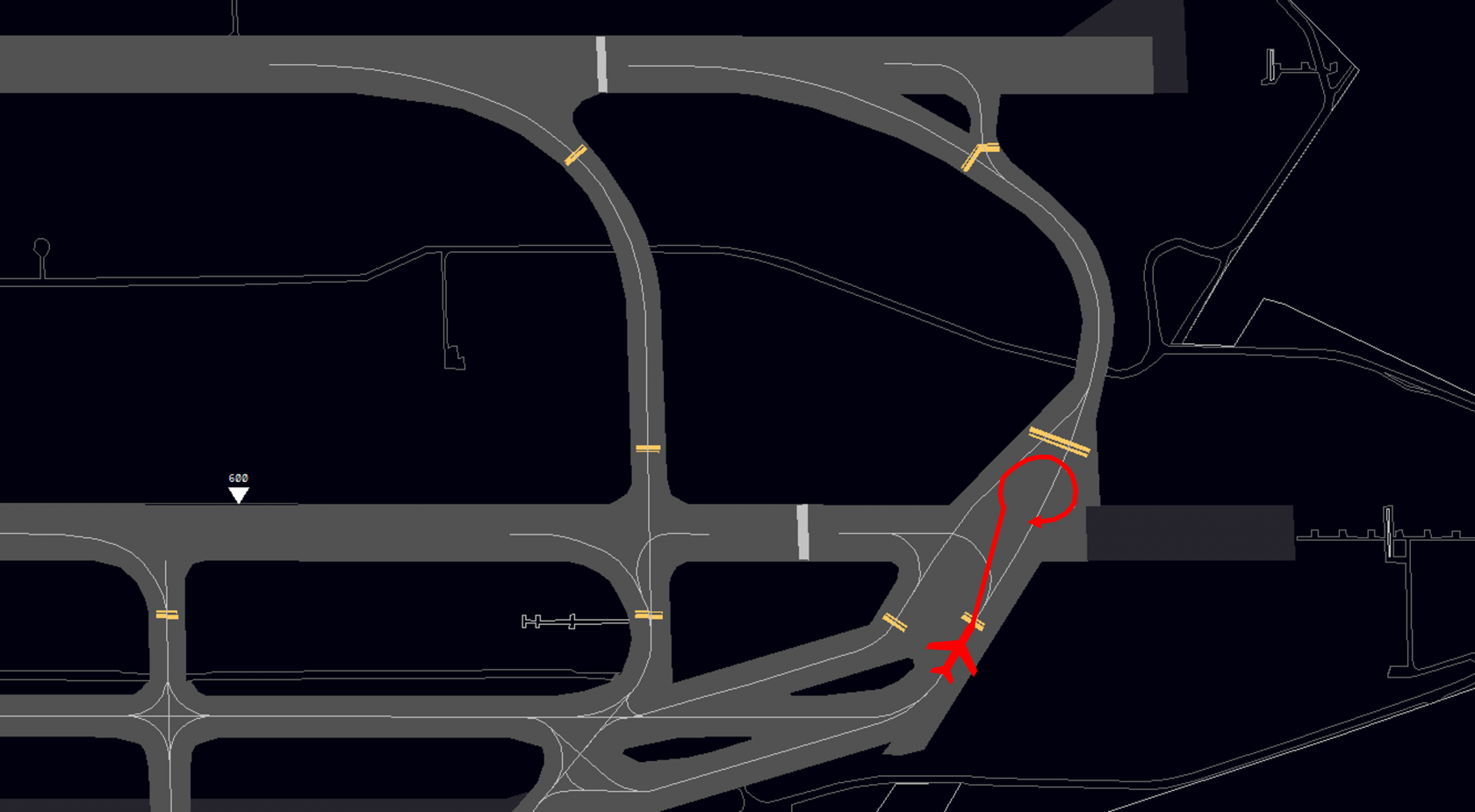](https://knowledgebase.vatsim-germany.org/uploads/images/gallery/2023-01/special-lineup.png) **High Traffic at Cologne:** During high inbound peaks into Cologne with 13 operations, Cologne Approach may use the Düsseldorf Approach sector. Therefore traffic departing Düsseldorf out of runway 23L/R to the south **require a startup and departure release** by Düsseldorf Approach. Tower will be informed by DLA and need to inform Delivery! ### Parallel Runway Operations and Runway Dependencies Due to the proximity, the parallel runways at Düsseldorf airport have to be considered as one runway in terms of runway separation. Treatment as one runway means that only one aircraft may use either runway at any time. This excludes taxiing, line-up instructions on the parallel runway and clearances to cross the parallel runway. For example, if there is approaching traffic on runway 23R, a take-off clearance on runway 23L can be given safely until the arriving traffic runway 23R is at approx. 3 NM (provided the departing traffic has already completed line-up). Depending on the approach speed, this 3 NM can also be undercut, but runway separation must be ensured at all times. This means that a previously departing aircraft must either have crossed the end of the runway or initiated a turn before the landing aircraft crossed the treshold on the parallel runway. The simultaneous use of both runways, e.g. for a northbound takeoff and a southbound takeoff, is never possible, regardless of aircraft type or flight rule! In the event of a missed approach, radar separation must be ensured between two IFR flights. At Düsseldorf, due to the proximity of the two runways, this requires active action by the tower controller, who must separate potential conflicts and coordinate them with the approach controller. The procedure **"not withholding takeoff or landing clearance"** can be applied, considering the parallel runways as one. With one exception: Since there are physically two runways and the rejected take-off does not have to be taken in to account, the landing clearance can already be given if the corresponding runway is clear. A take-off on the other runway must then be aborted if the runway separation can not be guaranteed. For departures after arriving traffic, the take-off clearence on the parallel runway can be given, as soon as the arriving traffic has touched down and begun slowing down. Since the runways in Düsseldorf are less than 760 m apart, **wake turbulence separation** must be ensured. ### Reduced Minimum Radar Separation Minimum separation of IFR flights approaching the parallel runway system (23L & 23R or 05L & 05R) can be reduced to 2.5 NM, according to AIP, if no **wake turbulence separation** has to be applied: > Reduced Minimum Radar Separation for Diagonal Staggered Approaches (Based on NfL I - 9/09) > > 1. The Minimum Radar Separation (MRS) for diagonal staggered approaches to parallel runways at Düsseldorf Airport is 2.5 NM between 10 NM and the touchdown point. > > 2. The reduced MRS will be applied to landing directions 05 and 23, provided > the following conditions are met: > \- Preceding and succeeding aircraft are approaching different parallel runways. > \- Both aircraft are established on the final approach track. *Quote from AIP Germany/AD 2 EDDL 1-23 (by the German Luftfahrt-Bundesamt), applicable on VATSIM.* ### Low Visibility Procedures LVO shall be announced in the ATIS (Code &lvp) and target spacing for arrivals shall be increased. Additionally, all traffic shall be told to hold at the CAT III holding points. RVR values will be given with the landing clearance and in the case of guided take-off (RVR ≤ 125m) with the take-off clearance. **Taxiway restrictions:** At runway visibiility ranges (RVR) less than 350 m, taxiway K and L5 between RWY 05R and taxiway M are closed. Additionally, it is not possible to vacate runway 05R via L8 and runway 23L via L3 with runway visual ranges of less than 350 m. Refer to this article for more information: [Low Visibility Operations (LVO)](https://knowledgebase.vatsim-germany.org/books/practical-procedures/page/low-visibility-operations-lvo). # EDDL - Approach 2501 Düsseldorf Approach is primarily responsible for all arrivals and departures at Düsseldorf Airport **EDDL** and Mönchengladbach Airport **EDLN**. If sector Bottrop (BOT) is not staffed separately, its tasks are also taken over by Arrival, which means that arrivals and departures to/from Niederrhein-Weeze **EDLV** and Geilenkirchen **ETNG** also are within the area of responsibility. ### Arrival Sector Overview The following two charts show the vertical and horizontal extent of the entire arrival and departure sector as well as the D-CTR and the lowered C airspace. In addition, the following neighbouring sectors border on Düsseldorf Arrival and the Bottrop sector: - **North**: Amsterdam Radar (EHAA\_CTR) - **East**: Langen Radar PADL (EDLP\_PAL\_APP) und HMM (EDDG\_HMM\_APP) - **South**: Köln Approach (EDDK\_APP) - **West**: Brussels Control (EBBU\_CTR)| [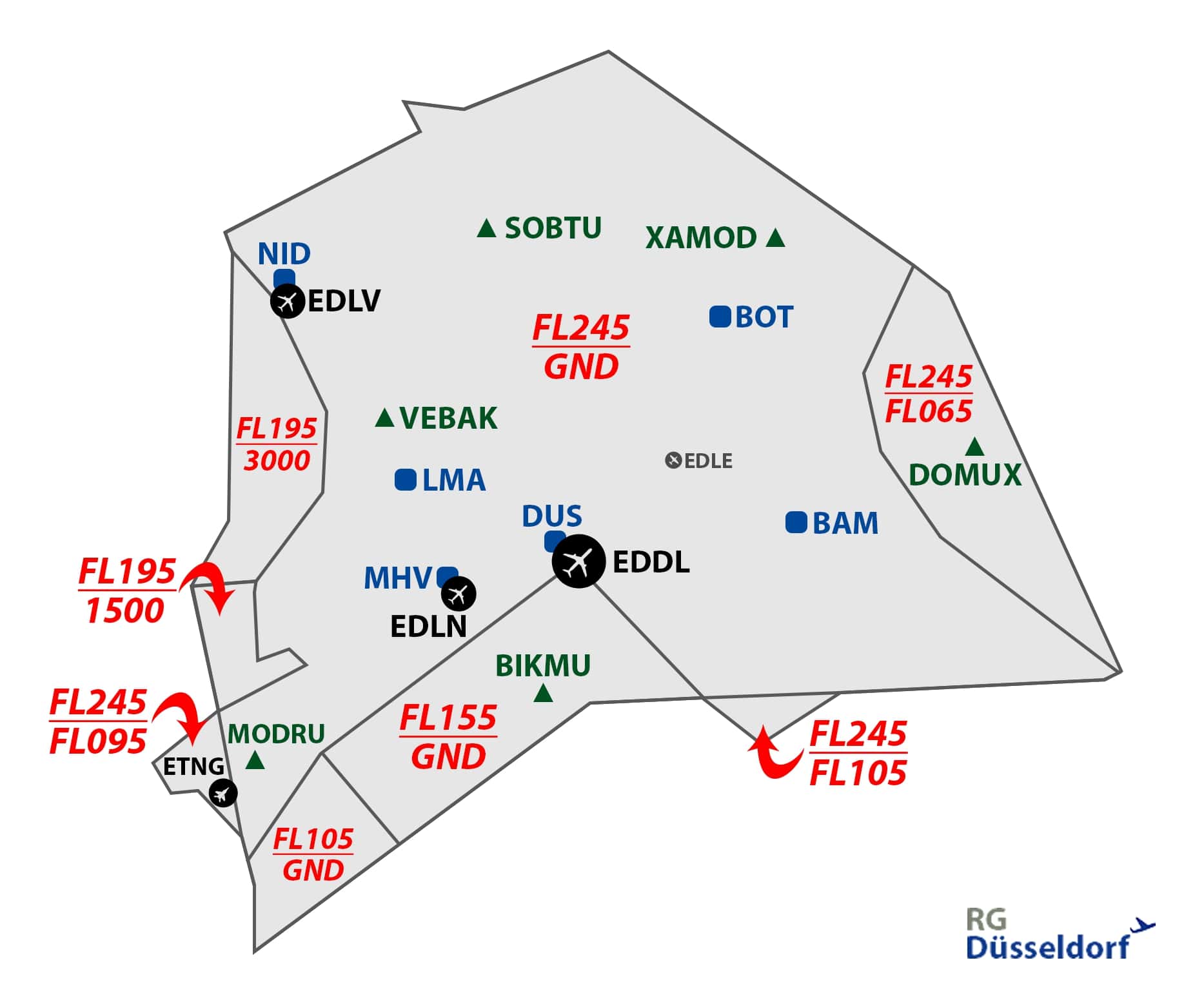](https://knowledgebase.vatsim-germany.org/uploads/images/gallery/2022-09/sops-edll-eddl-app-as.jpg) | [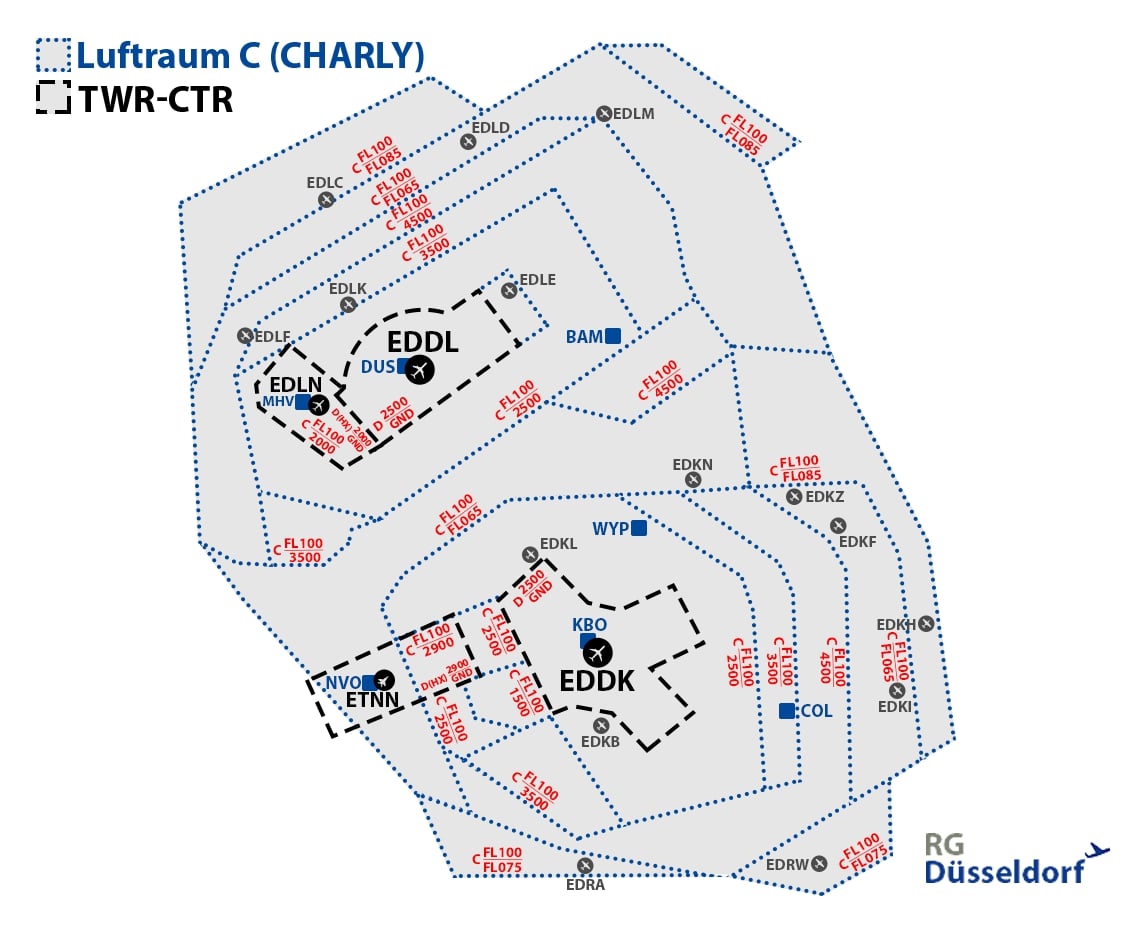](https://knowledgebase.vatsim-germany.org/uploads/images/gallery/2022-09/9sKsops-edll-c-lr.jpg) |
| *Sector Düsseldorf Arrival incl. Sector Bottrop* | *Airspace around Düsseldorf* |
DLA has to inform DUS Tower when this agreement is in operation!
#### Dortmund Area The area shown in red in the diagram is between GND and FL65 and is permanently under the responsibility of PADL for inbound and outbound flights from Dortmund EDLW. Düsseldorf Arrival must keep all its aircraft above FL70. For use with own aircraft below this altitude, an individual release from PADL is always required for each aircraft. [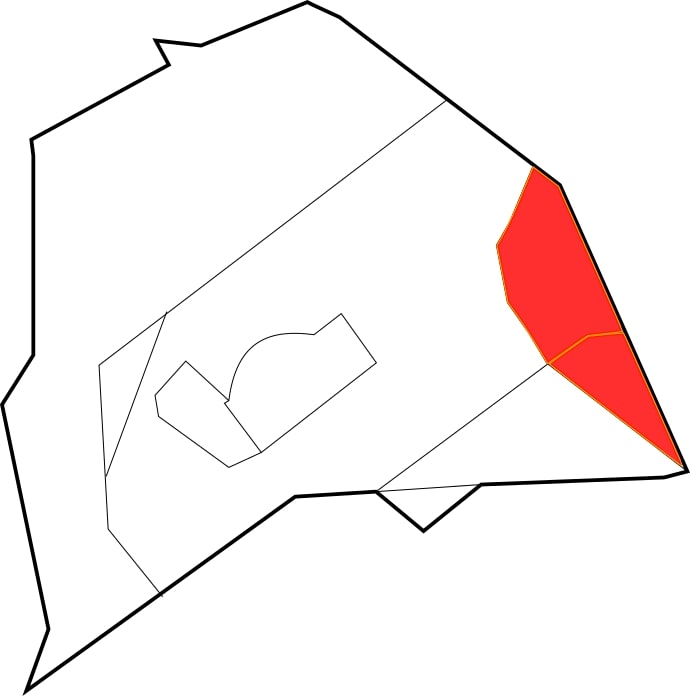](https://knowledgebase.vatsim-germany.org/uploads/images/gallery/2022-09/eddl-deli-edlw.jpg) *Dortmund Area | GND - FL65* ### Feeder - Düsseldorf Arrival (former Director) (DLAT) Düsseldorf Arrival can be split into two units to distribute the workload along two controllers with a lot of traffic. DLAT takes on the tasks of the feeder, while DLA handles the tasks of the so-called pickup. Both operate within the same airspace, so there are no fixed transfer conditions. However, certain aspects should be taken into consideration: - The pickup ensures that the aircraft have the correct ATIS, inform a/c about runway to land, and establishes a sequence. This is achieved by using speeds, vectors, or transitions, as well as appropriate and separated levels. Coordination of the sequence between both units is not required, as long as the pickup transfers the aircraft to the feeder in the order planned for the sequence. Any deviation from this order should always be coordinated. - The feeder's task is to line up the aircraft on final approach with optimal spacing. The minimum spacing for the same runway is 3.0 NM. If the aircraft are landing on different runways, the separation can be reduced to 2.5 NM within 10 NM of the threshold. - At the same time, there is a constant effort to balance the workload between both units. The pickup may also be occupied with other problems in the sector, which justifies the presence of a feeder even during heavy inbound traffic. Additionally, a feeder can, for instance, handle IFR cancellations for Essen inbounds on runway 23 or manage Mönchengladbach in- and outbounds during 05 operations, thereby relieving the pickup. This often makes sense because the feeder is already separating inbounds in this area anyway, which also reduces coordination to a minimum. - If the pickup is very busy however the feeder has less traffic, handoffs can be done early and without sufficient spacing, vectors or speeds as long as separation exists. In this case the feeder has the capacity to establish sufficient spacing and is able to reduce the workload of the pickup controller. - The workload balancing also works in the opposite direction. If the feeder becomes very busy and reaches his capacity limits, the pickup must ensure that aircraft are sent as simply and uniformly as possible. In such cases, aircraft should be transferred with sufficient spacing on the downwind at FL70 or FL80 and a speed of 220 knots. Significant deviations from the downwind make the feeder's job harder. If the aircraft are too low, there is a risk of entering the PADL Wickede during 23 operations. Additionally, this provides the feeder with enough levels to work with vertical separation effectively. ### Sector Bottrop (BOT) Sector Bottrop is responsible for the lower airspace approximately north of Düsseldorf and a small part above the arrival sector. In addition to arrivals and departures for Niederrhein-Weete (EDLV) and the Geilenkirchen military airfield (ETNG), its tasks primarily include through flights to and from Düsseldorf. [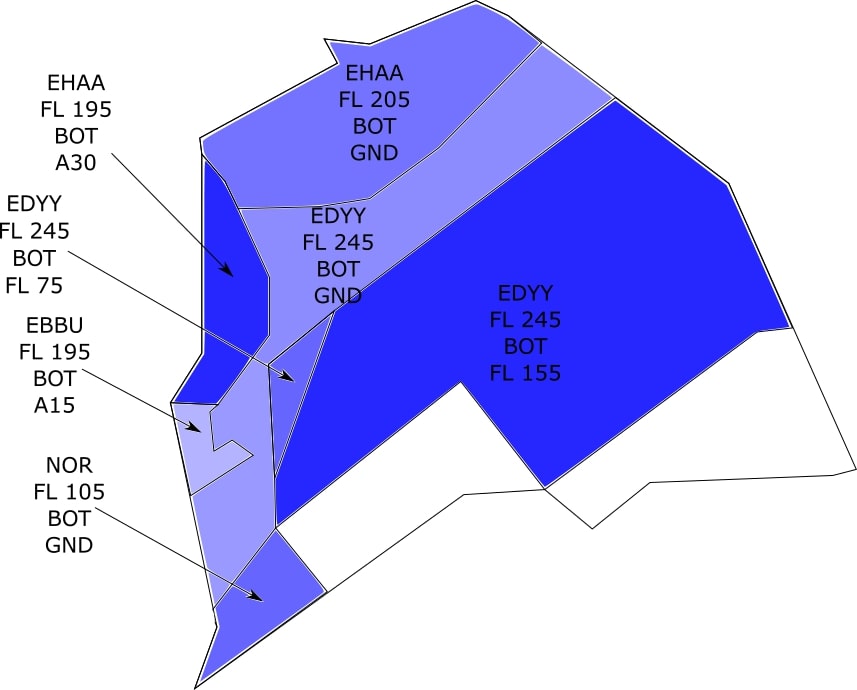](https://knowledgebase.vatsim-germany.org/uploads/images/gallery/2022-09/eddl-bot-sektor.jpg) *Border Langen Radar Sector Bottrop (BOT)* If the Bottrop sector is not staffed separately, it is taken over by Düsseldorf Approach by default. **Flights through BOT:** In addition to the flights to and from Düsseldorf, there are also flights in lower airspace and to destinations in the Netherlands, Belgium and Luxembourg. The respective transfer altitudes are published in the respective LoA. Flights to **Münster/Osnabrück (EDDG)** via BAMSU must be cleared for the BAMSU#J arrival before the transfer to the HMM sector takes place. ### Düsseldorf Departure (DLD) Düsseldorf Departure is responsible for departures out of Düsseldorf EDDL and Mönchengladbach EDLN. According to the departure procedures, pilots have to contact Departure when passing 2000ft AMSL.| [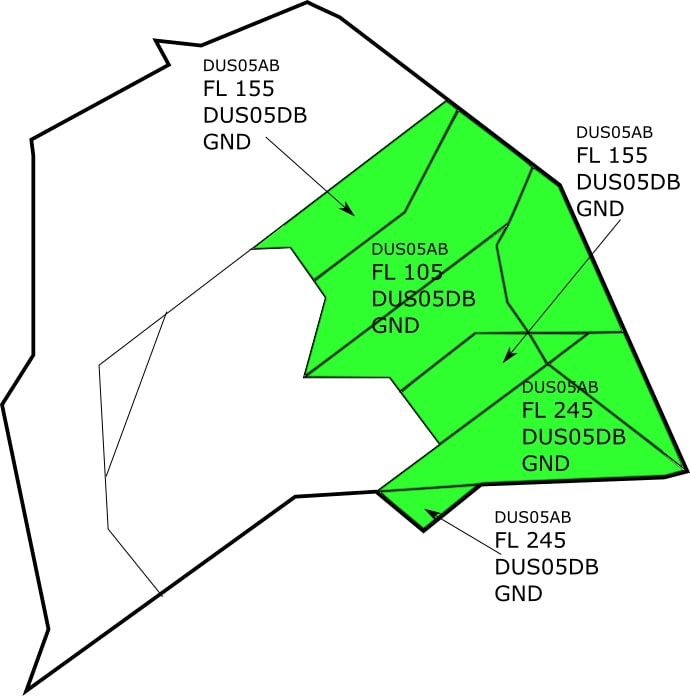](https://knowledgebase.vatsim-germany.org/uploads/images/gallery/2022-09/eddl-dus-d-05.jpg) | [](https://knowledgebase.vatsim-germany.org/uploads/images/gallery/2022-09/eddl-dus-d-23.jpg) |
| *Departure Sector 05 Operations* | *Departure Sector 23 Operations* |
| **DP** | **Location** | **max. Usage** |
| **DP1** | west of runway 18 | **Code E +** B748 |
| **DP2C** | west of runway 18 | **Code E +** B748 |
| **DP2E / DP2W** | west of runway 18 | **Code C** (B739/A321) |
| **DP3E / DP3W** | N7 blue/orange - **facing north** (!) | **Code C** (B739/A321) |
| **DP4E / DP4W** | V159 / V161- **facing south** (!) | max. 2 engined heavies |
| **DP5** | G16A | not used |
**A380s** have to **de-ice on position** prior pushback!
As soon as the aircraft is on the pad the pilot need to contact the "ice house" to coordinate the deicing process and further details (no Apron duty). After deicing the outbound needs to contact Apron again for further taxi to the holdingpoint. > **Frankfurt Apron**: DLH123 continue to DP2 Center, hold abeam the eyeline and contact ice house.Icehouse (all deicing duties itself and communication with the pilot) is not simulated at Vatsim Germany!
### Pad Usage Outbounds with **3 or 4 engines** departing **runway 25C** should always be **deiced on position** prior pushback! **DP1:** Primarily used for heavy traffic (prefered for 3/4-engine) for runway 18, possible for traffic departing runway 07C. **DP2:** Pad East and West is primarily used for traffic departing runway 18 and can be used for traffic departing runway 07C when required. DP2C is rarely used and only if no code C aircraft is waiting for de-icing. **DP3:** This pad is not prefered and should only be used when there is to much traffic for DP4 or DP1/DP2. Usually only used for traffic departing runway 25C/07C. When one of the pads is used, it's not possible to taxi via N7-orange/blue at all. Center Apron is always responsible for traffic to and from DP3. **DP4:** Prefered for departing traffic out of 25C/07C, but can be used for traffic departing runway 18 as well. Center Apron is responsible for traffic to the de-icing pad. Traffic leaving DP4 need to be coordinated or transfered to West Apron for taxi out. ### De-Icing Apron This position is only staffed during a high demand of remote deicing at DP1 and DP2. When the station is not staffed, West Apron is responsible for traffic to and from DP1 and DP2. De-Icing Apron is **only responsible** for traffic sequencing planned on **DP1 and DP2** as well as the Apron area at N-North/P1 (incl. F231 - F238 and V266 - V270). **[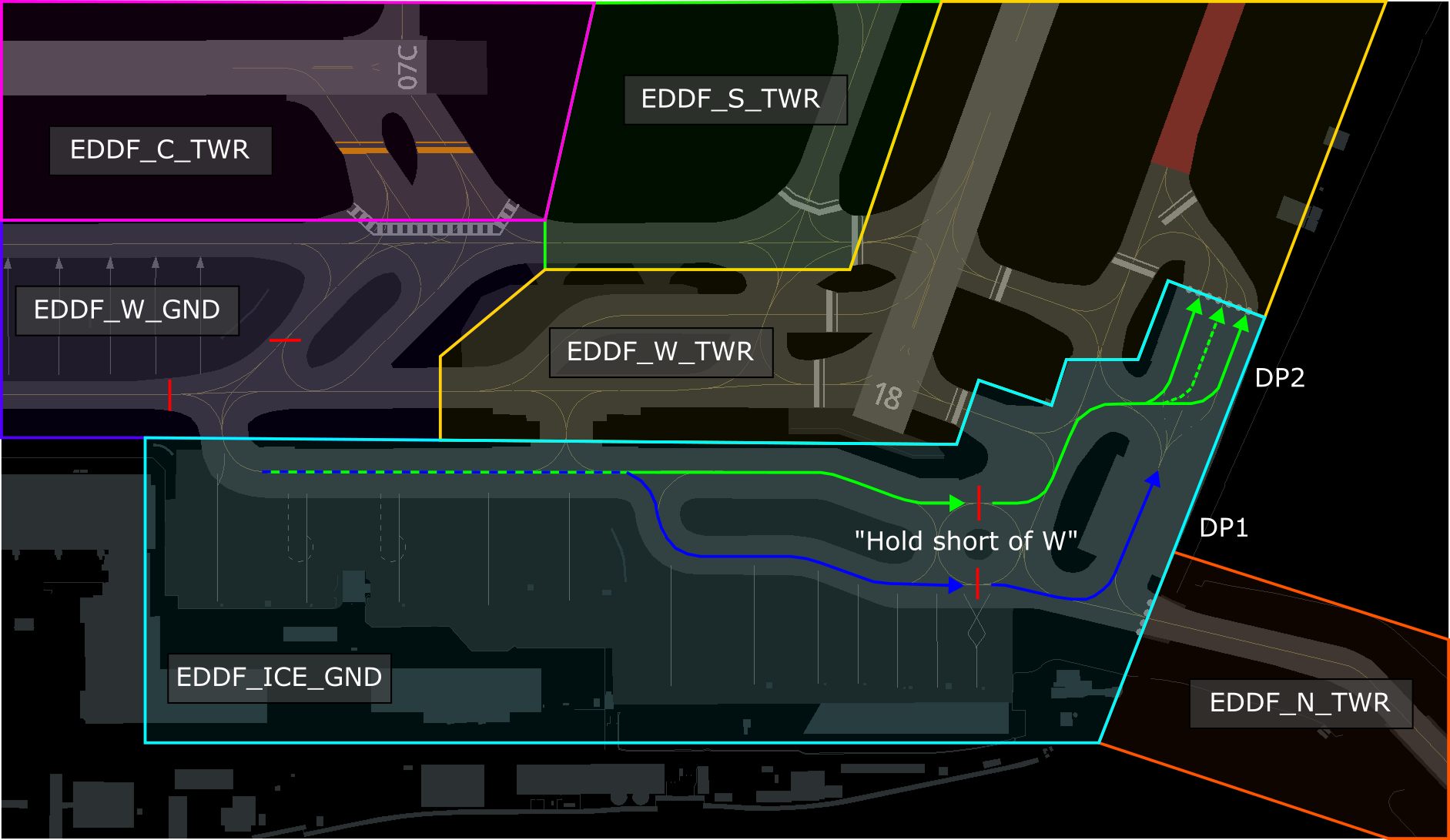](https://knowledgebase.vatsim-germany.org/uploads/images/gallery/2025-01/eddf-ice-gnd-aor.png)** *AoR De-Icing Apron* Inbounds and traffic for the pads is handed over from West Apron free off conflicts short of N15/N. Outbounds for DP1 and DP2 will not cross runway 18, they always have to use N-North/P1! Outbounds on the positions in this area are handed over from Delivery direct to De-Icing Apron. **Handoff Tower:** Outbounds from DP1 are send by Apron to W1 (18 departure) or W3 (07 departure for crossing runway 18) free of conflict. Outbounds from DP2 need to contact Tower to continue taxi to W3. All traffic is send to DFTW. **07 Departures:** All 07C departures from DP1 and DP2 have to cross runway 18 via W3 - L. **Apron West is responsible to keep L** between runway 18 and L21 **clear** for traffic to runway 07C. P1 can be closed on request by De-Icing Apron when to much traffic is waiting for deicing on P1/N-North. # EDDF - Apron/Ground 2501 Frankfurt **Apron** can be split into 4 stations as shown in the table and images below. Additionally, there exists a **Ground** station which will always be taken over by Tower though if not staffed. If more than one of these stations is staffed, Delivery needs to be staffed first. If just one Apron is online, this Apron takes over all other Apron stations, but not Frankfurt Ground.| **Station** | **Station ID** | **Login** | **Frequency** | **Remark** |
| **Center Apron** | DFGC | EDDF\_C\_GND | 121.855 | **primary** |
| **East Apron** | DFGE | EDDF\_E\_GND | 121.955 | **secondary** |
| **West Apron** | DFGW | EDDF\_W\_GND | 121.755 | will be taken over be DFGC if not staffed |
| **South Apron** | DFGS | EDDF\_S\_GND | 121.655 | will be taken over by DFGE if not staffed not yet operational in the real world |
| Deicing | DFGI | EDDF\_ICE\_GND | 121.985 | deicing operations only |
| Ground | DFG | EDDF\_GND | 121.805 | will be taken over bei DFTS if not staffed |
**Link 1** does not exist in real life anymore, and can not be found on any charts! Link 3 or N8 - N - N7 should be used instead.
[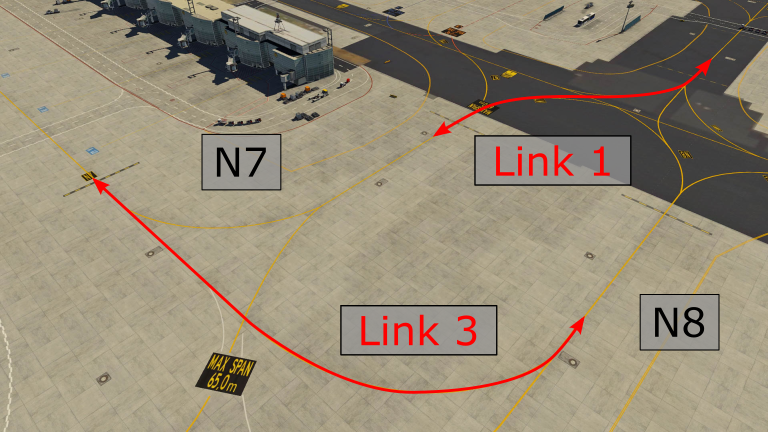](https://knowledgebase.vatsim-germany.org/uploads/images/gallery/2022-07/eddf-link1-link3-outside.png)*Usage of Link 1 and Link 3 between N7 and N8* #### Colored Lines Colored lines (orange and blue) can be used by all aircraft up to code C aircraft (A321/B739). Preplanning is required to use them the most efficient way. [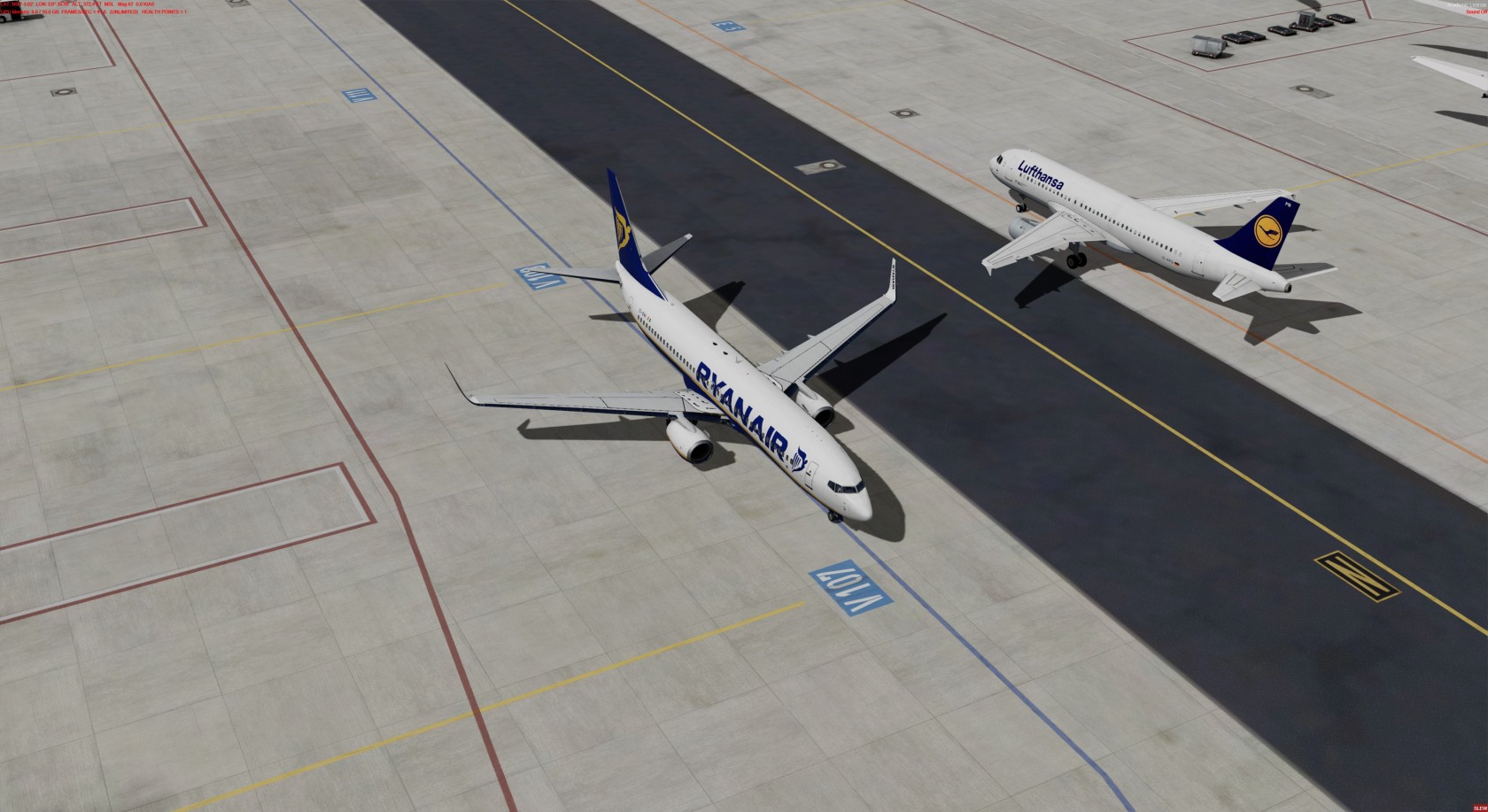](https://knowledgebase.vatsim-germany.org/uploads/images/gallery/2022-07/blueorange.jpg)*N-Blue and N-Orange used at the same time for parallel taxi* #### Pushback V134 - V178 (all facing south), as well as positions C2, B10 and A1 are taxi out positions. V143 and V144 are pushback positions! Almost all stands at the new GAT (V702-V721) are pushback positions, only V701 is a taxi out stand. ##### Straight pushbacks Pushback from positions **V108 - V118** (even numbers) always have to be done straight back. Straight pushback out of **V106** will end behind position V108 facing north, when a GSX profile is used. Otherwise the intersection L/N-East - T is blocked. > DLH123, pushback approved, straight back, no turn. [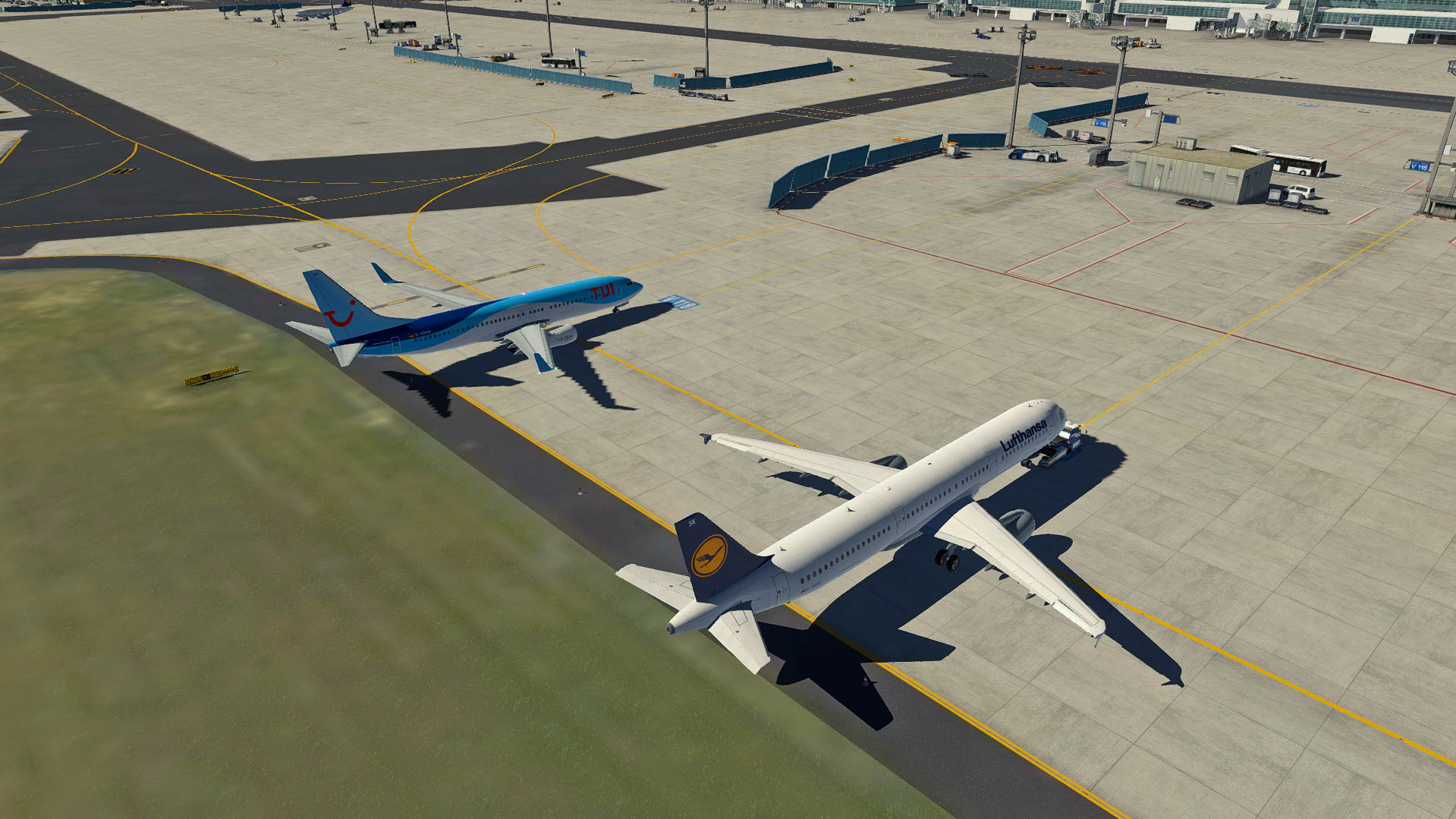](https://knowledgebase.vatsim-germany.org/uploads/images/gallery/2022-07/eddf-straight-push.jpg)*Straight pushback at positions V108 - V118 without turn* Straight pushback is also possible from positions V266 - V270 instead of using pushback areas 1 and 2. In the real world, a straight pushback from V270 will result make a slight curve to end up behind stand V269 facing North. Some GSX profiles may simulate this, so controllers should consider V269 blocked until the straight pushback from V270 has concluded. ##### Pushback Areas Various areas of Frankfurt's apron utilize predefined pushback areas to which pilots can be instructed to push. Depending on the combination of the stand and the pushback area, a push and pull maneuver may be required which not all pilots are able to comply with; if in doubt, controllers should ask the pilot if they are able to conduct a push and pull maneuver. Additionally, some GSX profiles now only offer presets for these areas at appropriate parking positions so pilots may explicitly request an area if they are given a normal pushback; this should be accommodated when possible, but GSX also allows pilots to manually edit their pushback route, so when a normal pushback makes more sense, the pushback to an area can also be denied. These areas are always only available for the applicable yellow taxiline; when instructing an aircraft to push onto a colored line, areas may not be used.As charts don't inform pilots of the possible directions for each area, the **direction shall always be given with the clearance when instructing a pilot to push to an area**.
| **Taxiway** | **Area** | **Nose gear abeam stand** | **Facing** | **Restriction** |
| N | 2 | E5 / V111 | *West/East* | |
| N-East | 1 | *nose gear abeam service road between V106 and V107* | North | |
| N3 | 1 | C6 / B44 | South | max. Code C |
| 2 | C11 / B45 | South | max. Code E | |
| N5 | 1 | A15 / B22 | South | max. Code C |
| 2 | B25 / A21 | South | max. Code E | |
| 3 | B26 / A25 | South | ||
| N7/N8 | 1 | A16 | West | max. Code C |
| 2 | A24 | South-West | max. Code E | |
| 3 | A58A | West | ||
| 4 | A30 | West | max. Code C | |
| 5 | A58B | East | max. Code E | |
| 6 | A40 | West | max. Code E | |
| 7 | A66B | West | ||
| 9 (should not be used) | *short of N* | South | ||
| P1 | 1 | F238 | *West/East* | |
| 2 | V267 | West | ||
| S4 | 1 | G6 | North | |
| 2 | G12 | North | ||
| S5 | 1 | H4 | North | max. Code C |
| 3 | G13 | North | ||
| S7 | 2 | H12 | North | |
| S11/S15 | 6 | V326 | North | |
| 7 | *short of S* | North | ||
| 1 | K4 | West | max. Code C | |
| 2 | K10 | West | ||
| 4 | *short of S11* | West | ||
| L | 1 | V94 | West | max. Code C |
| 2 | V97 | West | max. Code C |
The first apron controller the inbound traffic contacts will always tell them their gate, even if it's under another Apron's responsibility.
> **Frankfurt Apron (West)**: DLH1255, gate A25, taxi via N11, L hold short of N8. > > **Frankfurt Apron (West)**: DLH1255, contact Apron on 121.855. #### Inbounds 25C/07C Inbound traffic from runway 25C/07C will be handed over from Tower with a hold short of L. This traffic is still blocking the runway after vacating and has to be treated with number one priority. #### Handoff Handoff to the next Apron controller will always take place with a hold short instruction of the next intersection close to the border of the area of responsibility (e.g. traffic from Center to West at N with a hold short of N10). Do not label any hold short for the transfer that is defined by the SOP! #### Traffic Flow If you have any “potential conflict” that will just generate waiting time for the pilot, please try to solve the problem without assigning a new gate. That will improve your preplanning skills a lot. Always try to work with conditional information as precisely as possible, but do not overload the pilot with useless information! > **Frankfurt Apron**: DLH123 at L give way to opposite company A320. > > **Frankfurt Apron**: DLH456 at N4 number two behind Singapore A350 from right. > > **Frankfurt Apron**: DLH789 behind opposite British Airways A319 taxi to holding point runway 18 via N, hold short of N5. ##### Tricks - keep the traffic flow dynamical and use conditional instructions as often as practicable. Resolve a hold short with a conditional instruction as soon as practicable. - you may deviate from the default taxi flow (coordination might be required) to enable an efficient flow (e.g. via N3, N, N1 instead of L). - you may have to adjust the routing to avoid conflicts and holdshorts - you have to monitor taxiway M and the holding points to see what you can expect entering your sector within the next minutes ### Use of Intersections**Runway 07C/25C:** Apron will not clear outbound traffic into intersections for runway 25C/07C. All outbounds are instructed to hold short of the intersection and Tower will instruct them to join the intersection that might be the best for the departure sequence.
> **Frankfurt Apron**: DLH123, taxi to runway 25C via N4 and L, hold short of L3. > **Frankfurt Apron (Center)**: DLH505, taxi to runway 25C via N8 and L, hold short of N4. > > **Frankfurt Apron (Center)**: DLH505, contact Apron on 121.955. > > **Frankfurt Apron (East)**: DLH505, hallo, continue via L, hold short of L3. > > **Frankfurt Apron (East)**: DLH505, contact Tower on 118.780. > **Frankfurt Apron**: AAL71, taxi to runway 25C via N, N1, hold short of L. > > **Frankfurt Apron**: BAW906U, taxi to runway 18 via orange line and N, hold short of N5. It is important that every handoff takes place as early as possible and has to be free of conflicts. Every potential conflict needs to be solved prior to the handoff. As soon as the outbound traffic is in contact with Tower, it is released by Apron up to L1 and Tower has the possibility to use every further intersection available. Even if the pilot reported to Apron to be able for L6, Tower still can use L3 (or L1) intersection if there is no benefit for the outbound to use an intersection. In that situation with traffic on L under control of Tower, other outbound traffic e.g. joining L via N3 needs to be number 2 behind the traffic on L. Intersections a pilot is able for should be noted in the remarks. Do not label any hold short for the transfer that is defined by the SOP! Keep in mind that if you would like to solve a conflict it might be useful to let outbound traffic continue via L even if he would be able for L6. **Runway 18:** Departures out of runway 18 will always be sent directly to the holding point via N/L. Handoff should take place early, so that Tower still has the chance to take outbounds via N-South. During 25 operations intersection L needs to be coordinated. During 07 Operations N is still preferred for all heavy aircraft (routing via L, N14, N). During high traffic load (decision rests with apron control) All MEDIUM and LIGHT aircraft departing via runway 18 and parking east of taxiway N3 shall be asked if they are able for departure out of intersection S. If they are, they should taxi to hold short of U2. Frankfurt Ground is responsible for further taxi (see "Transition 1" below). > **Frankfurt Apron**: DLH123A, advise able to depart from runway 18 intersection S? ### Transition 1 Outbounds via runway 18 intersection S will taxi via the southside of the airport and are transferred from Apron to Ground (if staffed, otherwise Center Tower) short of stopbar U2. Further taxi will be issued via U - S - S11 - R - S28 - S. Explicit crossing of stopbars U2 and U6 is required. This is a standard taxi routing called "Transition 1". It can only be found in the AIP EDDF, there are no markings on the taxiways. > **Frankfurt Ground:** DLH123A, cross U2 and U6, taxi via transition 1 to holding point S runway 18. If the pilot seems to be unfamiliar with Transition 1, issue the taxiways as usual. Depending on the inbound traffic for runway 25L/07R (there should be no opposite during taxi) further taxi via M can be used to save time. ### Runway Crossing The taxiways used for crossing are based on the planned parking position and runway in use (see image below). These taxiways are mandatory and only if a pilot uses the wrong taxiway the Tower controller should deviate from that after coordination with Apron. It is also possible to coordinate a different crossing taxiway (M6, M10, M30, Y, T) or procedure between Tower and Apron for crossing. **LVO:** During LVO inbound traffic landed on runway 25L/07R will not cross the center runway. All traffic needs to taxi via T or Y, depending on their planned stand.Tower is not allowed to issue take-off clearances as long as the intersection is blocked by just crossed traffic. That’s why **Tower will issue the initial taxi route after crossing** to the Pilot. This depends on the runway in use and the intersection used (see images).
When traffic crossed the runway it shall be sent to the according apron control as soon as possible, so traffic does not need to stop. Apron is responsible for separation in the Apron at all times. Tower can issue the crossing clearances without looking at potential conflicts. A lot of planning is required for that.| **Entry** | **Stand** | **Hold short of** |
| **P** | all except those via P1 | N11 |
| **P1** | F231 - F238 and V266 - V270 | W |
| **S4 - S23** | South Parking (S, V3xx, J, K, G) | S4 - S23, according to the stand |
As a rule of thumb, the crossing clearance at a stopbar for may be given when the inbound is on minimum 4 NM final.
[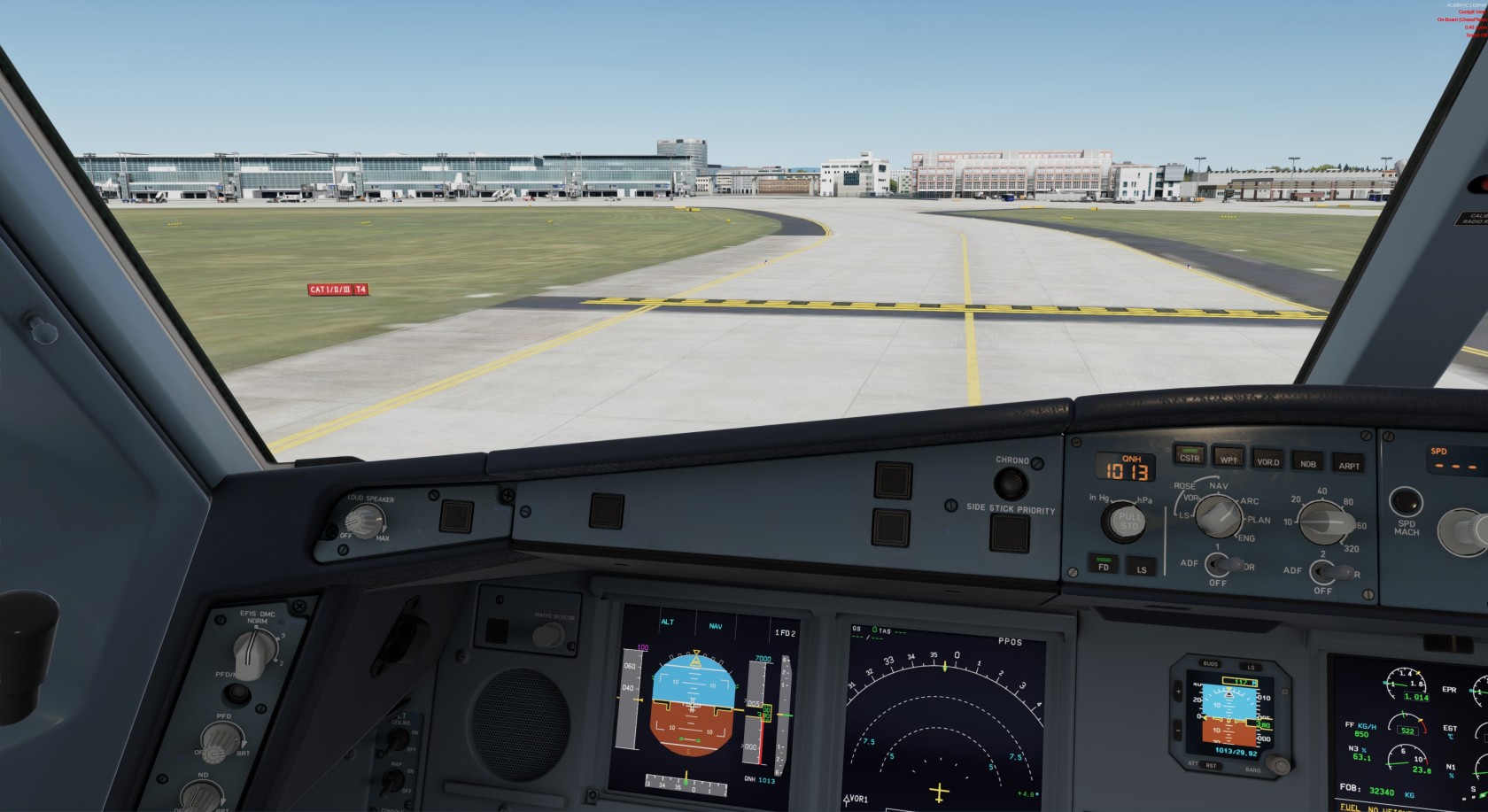](https://knowledgebase.vatsim-germany.org/uploads/images/gallery/2022-07/eddf-t4.jpeg)*Inbounds have to hold short of stopbar T4 (yellow lines on the ground).* *Name of the stopbar at the red sign on the left.* **Stopbars at Y:** There must not be any traffic between Y4/Y10 and Y2 (RWY 07C) or Y6/Y12 and S40 (RWY 07R), when there is landing traffic vertically above TWY Y or outbounds runway 25C/25L still below 500ft AGL. ### Specialties during 07 Operations **Border at N5:** Traffic from Center to East Apron needs to hold short of N5. As soon as the handoff is initiated, this traffic is released and will always be number one (green aircraft). Only hand off aircraft which you do not need to stay there (e.g. if you would like to have your outbound at N5 as number 1 - see image, THY25L).| **Station** | **Station ID** | **Login** | **Frequency** | **Remark** |
| **Center Tower** | DFTC | EDDF\_C\_TWR | 118.780 | **primary station** |
| **West Tower** | DFTW | EDDF\_W\_TWR | 124.855 | **secondary station** |
| **North Tower** | DFTN | EDDF\_N\_TWR | 136.500 | will be taken over by DFTW if not staffed |
| **South Tower** | DFTS | EDDF\_S\_TWR | 119.905 | will be taken over by DFTC if not staffed |
| **Ground** | DFG | EDDF\_GND | 121.805 | will be taken over by DFTS if not staffed |
| **Runway** | **Usage** | **Remark** |
| **25C / 07C** | Departure | for emergencies and swingovers also for landings (coordinate exceptions) |
| **25R / 07L** | Landing only | not allowed for A380, B747, DC10, MD11, L-1011 |
| **25L / 07R** | Landing | for VFR traffic and outbounds from the south apron also for departures |
| **18** | Departure only | -- |
**Rule of Thumb for aircraft with same performance:** A separation of 3 NM can be achieved when the succeeding traffic receives its takeoff clearance as soon as the preceeding traffic is overflying the end of the departure runway. For a separation of 5 NM the proceeding traffic needs to be 2 NM away from the end of the departure runway.
**Same SID, different runways:** Especially between southern departures out of runways 07/25 and 18, Tower has to pay special attention to initial separation. All departing aircraft out of Frankfurt must be instructed to contact the appropriate Langen Radar frequency after departure. This instruction shall be given when the aircraft is airborne and free of conflict with other departures and / or missed approaches. The transfer should be initiated early enough to avoid the flight leveling off (at +/- 1000 ft AMSL). As the approach / departure controller shall always cross-couple both real-life departure frequcneies, the departure frequency will always be 120.155 for departures towards MARUN, TOBAK, OBOKA and 136.130 for departures towards SULUS, KOMIB, CINDY, ANEKI, SOBRA and ULKIG. #### Arriving Traffic For inbounds, Frankfurt Arrival is responsible for separation until transfer of communication. The minimum separation between two aircraft approaching the same runway is **3 NM or wake turbulence separation**, whichever is higher. However, under certrain circumstances, the radar separation can be reduced to **2.5 NM** according to NfL I-55/11: - Both aircraft are within a 10 NM final - The preceding aircraft has the same or a lower weight category. Aircraft of weight category SUPER, HEAVY and the B757 as preceding aircraft are excluded from this procedure. - The exit taxiways of the runway can be observed from the control tower visually or by means of surface movement radar (always applicable at VATSIM) - The runway is dry The reduced radar separation minimum may also be applied between alternating approaches to the parallel runways (see below). In these cases, neither the line of sight of the exit taxiways nor the runway conditions need to be considered as a precondition. Langen Radar should not use separation less than 3NM on purpose. However, the use of reduced minimum radar separation on final approach can avoid the need for missed approaches. **Modes of Operation:** Langen Radar has to coordinate with tower whether parallel independent, dependent or alternating (former staggered) mode will be used. The minimum separation between an aircraft on final runway 25L/07R and another aircraft on final runway 25R/07L is measured diagonal head to head.| **Mode** | **Minimum separation 25L/07R - 25R/07L** |
| alternating | 2.5 NM |
| dependent | 1.5 NM |
| parallel independent | independent |
| [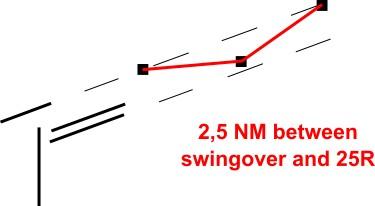](https://knowledgebase.vatsim-germany.org/uploads/images/gallery/2024-10/eddf-separation-swing.jpg) | [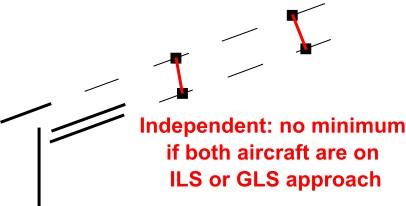](https://knowledgebase.vatsim-germany.org/uploads/images/gallery/2024-10/eddf-seperation-independant.jpg) |
| [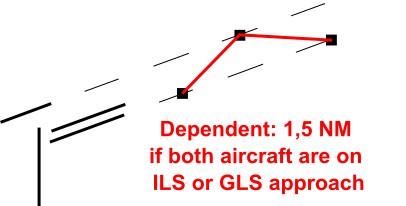](https://knowledgebase.vatsim-germany.org/uploads/images/gallery/2024-10/eddf-seperation-dependant.jpg) | [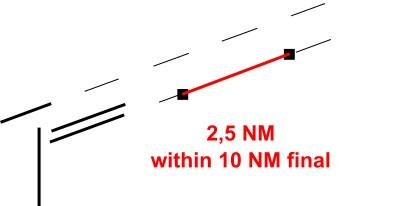](https://knowledgebase.vatsim-germany.org/uploads/images/gallery/2024-10/eddf-seperation-same-rwy.jpg) |
**Target spacing** for inbounds only need to be applied by Arrival when **requested by Tower!** Otherwise radar or WTC separation is used by default.
#### 25 Operations **M/H-Departure and departures to the south (e.g. CINDY#F):** Takeoff clearances for runway 25C/25L can be issued when the following conditions are met: - **Inbound Traffic:** For departures out of runway 25C there is no aircraft between 4 NM final and threshold runway 25L. The takeoff roll has to start before any inbound for runway 25L reaches 4 NM final (only applicable for inbounds runway 25L, not for swingovers runway 25C). For runway 25L inbounds and outbounds, only runway separation has to be applied. - **Outbound Traffic:** As soon as departures out of runway 18 started the takeoff roll, there is no further dependency between 18 and M/W/H/K SIDs from runway 25C/25L. **G/F-Departure to the north:** Takeoff clearances for runway 25C/25L can be issued when the following conditions are met. - No aircraft between 0,5 NM and 4 NM final runway 25R, takeoff roll has to start before any traffic inbound runway 25R reaches 4 NM final - (Independent to arrivals on runway 25L) - (25C: Independent to departures from runway 18) - Departures out of runway 25L need a release by DFTW. The release can be given once the departure from runway 18 is rolling. - During LVO both tabu zones for 25L and 25R need to be clear of traffic when starting the takeoff roll. Since this is almost impossible during high inbound traffic, all departures should receive the M/H SIDs during LVO so that only one taboo zone has to be considered. **18 Departures:** Outbounds from runway 25C/25L with initial turn to the south need to reach 2000ft AMSL before the takeoff clearance can be issued. Outbounds from runway 25C directly to the north are completely independent to all 18 departures. 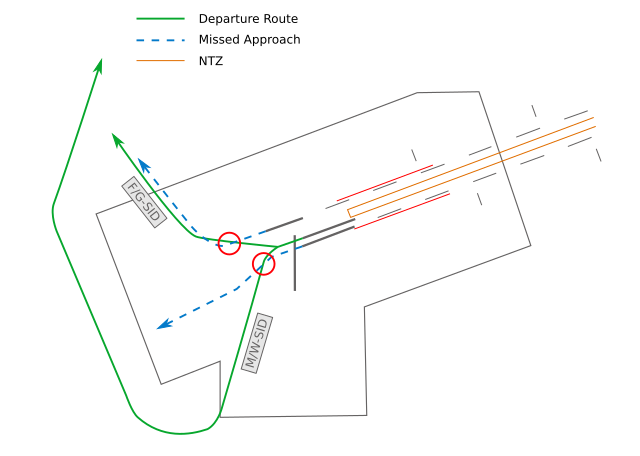*dependencies during 25 operations* **Missed Approaches:** Missed approaches from runway 25C and 25L are dependent to runway 18 departures. The takeoff clearance on runway 18 can be given, as soon as separation is ensured. Exception: Departures from intersection S are independent to missed approaches. However, a traffic information could increase the situational awareness of the pilot. **Staffing with multiple tower:** If more than one Tower position is staffed, DFTW is responsible for the coordination between departures runway 18 and 25C/25L. DFTC/DFTS always needs a release by DFTW for all departures with initial turn to the south (M / W / H / K / N / F-SIDs to the south), if not coordinated otherwise. E.g. the phrases "Released" / "DLH123 released" / "MARUN released" may be used. #### 07 Operations **Outbounds 07:** All outbounds out of runway 07C are independent to all arrivals on runway 07R and departures on runway 18. In case of a go around on runway 07R, Tower has to ensure separation. In case of a southbound departure from RWY 07C, the missed approach should be turned to the south above the MVA and the departure should stay on runway track. Missed approaches on RWY 07L and OBOKA/MARUN#E departures are **not** separated procedural. In case of go around on runway 07L, Tower has to ensure separation with departures out of runway 07C. **18 departures:** Departing aircraft on runway 18 from N / N-South / L have to start their takeoff roll before any aircraft on final runway 07R is between 4 NM final and runway 18. Also, traffic departing from these intersections need to be separated by time-based wake turbulence behind arrivals on runway 07R (see table below). For departures out of **intersection M** it must only be ensured that the inbound will not overfly the departing traffic on runway 18, so the 4 NM restriction does not need to be taken into account as well as wake turbulence separation. Departing taxi out of full length can taxi down the runway to intersection M (not via taxiway Y) to improve the departure sequence. > DLH123, lineup runway 18, on the runway taxi down to intersection M. Outbounds via **intersection S** are completely independent to arrivals for runways 07C and 07R. ##### Time-based wake turbulence separation 18 Outbound vs. 07R Inbound| **Preceding** | **Succeeding** | **Separation** |
| Medium | Light | 2 min |
| Heavy | Light | 2 min |
| Medium | 2 min | |
| Super | Light | 3 min |
| Medium | 3 min | |
| Heavy | 2 min |
Tower will get Outbounds for runway 07C/25C short of the intersections. The intersection to use can be decided by Tower depending on the best departure sequence. Therefore only L1, L3, L4, L5, L6 and L9 can be used during 25 operations and L14, L16, L17, L19, L20, L21 for 07 operations. Tower needs to instruct the pilot to join the intersection.
To protect the center runway, all traffic holding short **can** be instructed to stop at the CAT II/III holding point (real procedure)! As many pilots are confused by this instruction, a "normal" hold short of the runway can be used instead.
> **Frankfurt Tower**: DLH123A, taxi via M and M8, hold at CAT II holding point runway 25C. > or > **Frankfurt Tower**: DLH123A, taxi via M and M8, hold short of runway 25C. During 07 Operations inbounds landed on runway 07L with parking position west of N11 should be transferred directly to West Apron.   Inbound traffic entering the Apron without crossing the runway will be instructed according to the table below. Frankfurt Apron is always responsible for all GAT and movements at the southern apron!| **Entry** | **Stand** | **Hold short of** |
| P | all except those via P1 | N11 |
| P1 | F231 - F238 and V266 - V270 | W |
| S4 - S23 | South Parking (S, V3xx, J, K, G) | S4 - S23, according to the stand |
Do not label hold shorts that are defined by the SOP!
### Visual Swingovers Inbounds for runway 25L have the possibility to do a visual swingover (visual approach) to runway 25C when reaching the 7 NM final (2500ft MSL). Therefore the pilot has to have the runway in sight. During 07 operations a swingover is only available for safety reasons or to avoid a missed approach. **Dependencies:** Visual swingovers are dependent to approaches on runway 25R/07L, even when using parallel independent operations! They do not have to be coordinated with Langen Radar as long as separation to other aircraft is obviously great enough. The **succeeding** aircraft has to confirm the parallel traffic in sight and maintain visual separation. **Missed Approach:** With the clearance for the visual approach the pilot has to be given a new instruction how to continue in case of a missed approach. Therefore runway track and a climb to 5000ft shall be used. > **Frankfurt Tower**: DLH123, advise able for visual approach runway 25C and parallel A320 2 o'clock in sight? > > **Pilot**: Able and in sight, DLH123. > > **Frankfurt Tower**: DLH123, maintain own separation, cleared visual approach runway 25C, (do not overshoot to the north). In case of missed approach climb straight ahead 5000ft (and contact Frankfurt Tower 118.780). A swingover can have several benefits. Separation minima can be reduced (described below) or safety reasons e.g. to avoid missed approaches. Pilots are often happy about reduced taxi times on ground. **Swing to depart**: A swingover can also be used to improve the outbound flow for runway 25C with M/W departures, as there is no 4 NM no-fly zone that need to be taken into account. A takeoff clearance on runway 25C can also be issued if the inbound is closer than 4 NM, which would not be possible if this traffic was approaching runway 25L. The inbound will be handed over to the according apron, with a hold short of L, as soon as possible. > **Frankfurt Tower**: DLH123, vacate to the right, hold short of L and contact Frankfurt Apron 121.855. ### Low Visibility Operations LVO become effective once the **ceiling / vertical visiblilty is below 200ft or the vertical visibility cannot be detected or any RVR in the METAR is equal or below 600m.** During LVO, the following procedures shall be applied: - LVO shall be **announced** in the **ATIS** (Code "&lvp") - Only the **Z ILS** for the northwestern RWY may be used - All traffic shall be told to **hold at the CAT III holding points** - The **RVR value for the corresponding runway** shall be given with the **landing clearance** and in the case of guided take-off (RVR ≤ 125m) with the take-off clearance - **25 Departures** should only depart from RWY 25C via **M/W SIDs** (reason: F/G Departures and a missed approach on runway 25L would mean a loss of separation during bad weather, but M/W SIDs are independent to published missed approaches from runway 25R) - **Runway crossings are not allowed** - During RWY 25, landing traffic that would cross via M8 shall taxi via T and traffic that would cross via M30 shall taxi via Y - During RWY 07, all landing traffic shall taxi via T - Optional procedures for advanced controllers: Consideration of sensitive and critical areas of the ILS - The sensitive and critical areas for every runway and aircraft category can be displayed in Euroscope via Functions -> Maps -> LVP - [](https://knowledgebase.vatsim-germany.org/uploads/images/gallery/2024-11/screenshot-20.png) Yellow areas show the sensitive areas - [](https://knowledgebase.vatsim-germany.org/uploads/images/gallery/2024-11/screenshot-22.png) Orange areas show the sensitive areas for non-orthogonal and non-parallel traffic - [](https://knowledgebase.vatsim-germany.org/uploads/images/gallery/2024-11/screenshot-21.png) Red areas show the critical areas - The wake turbulence category always refers to the preceeding aircraft on the runway, not the suceeding on final - For Light and Medium aircraft, there are no restrictions except that they must be clear of the CAT III holding point before the next inbound is over the runway threshold - For Heavy / A388 aircraft: - Sensitive areas must be clear as soon as the next inbound is within 2 NM final - As a rule, sensitive areas are always clear when the aircraft has passed the CAT III holding point - Critical areas must be clear as soon as the next inbound is within 4 NM final - When applying these advanced procedures, the following spacing should be the coordinated with APP for arriving flights: - 5 NM behind Light / Medium aircraft - 7 NM behind Heavy / A388 aircraft # EDDK - Ground 2501 ### Airport layout Cologne-Bonn airport has three crossing runways. [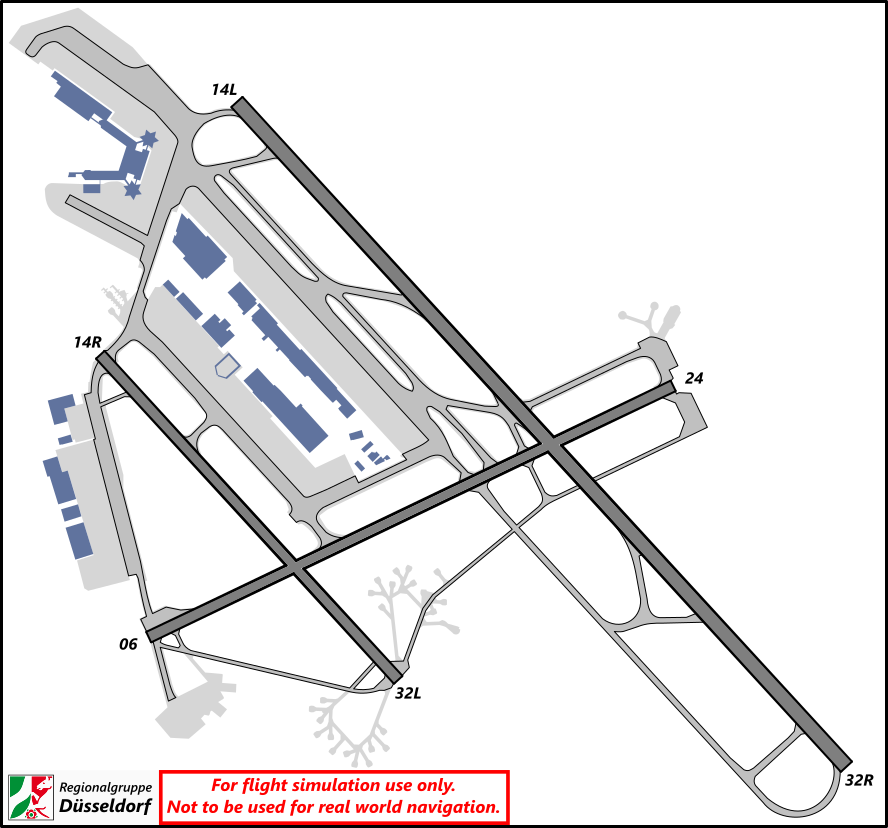](https://knowledgebase.vatsim-germany.org/uploads/images/gallery/2022-09/eddk-overview.png)*airport layout* The airport has two passenger terminals. Terminal 1 with its two distinctive stars accommodates aprons A, B and C, and Terminal 2 with the apron area D. [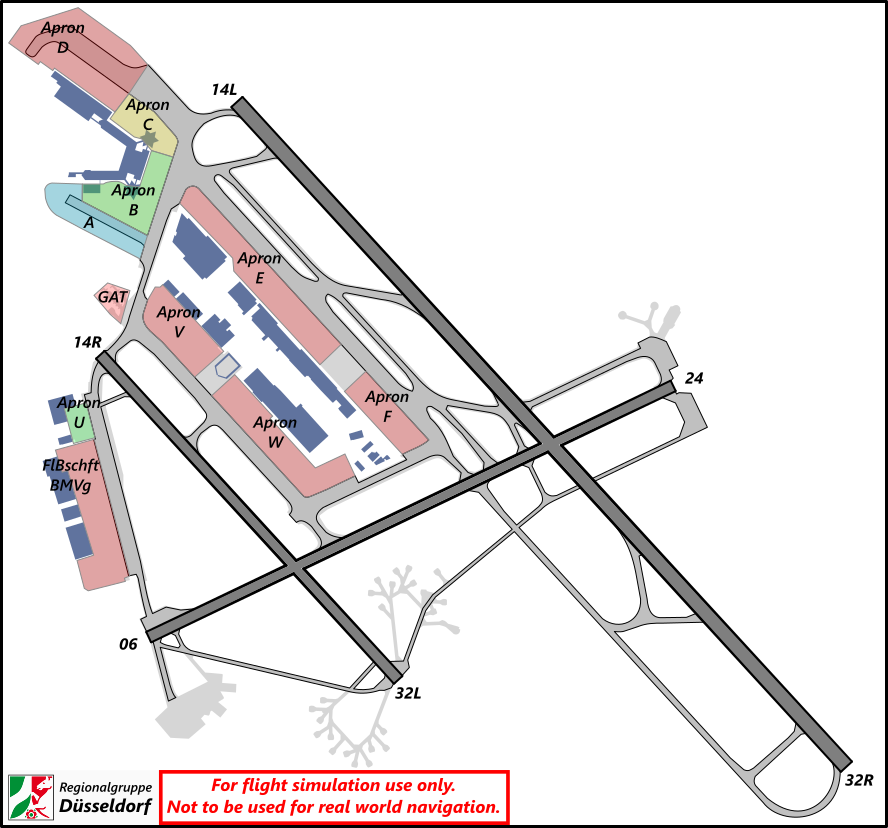](https://knowledgebase.vatsim-germany.org/uploads/images/gallery/2022-09/eddk-apr.png)*Apron areas* The cargo area is used by several airlines and is located in the middle of the airport between the runways. It contains the apron areas E, F and W. Apron V close to the cargo area is used for general aviation and business jets. The military part of the airport is located west of runway 13R/31L at apron U. The military part of the apron is the home of the german Flugbereitschaft. ### Area of Responsiblility The area of responsibility of Ground is located between the three runways and includes all aprons except the military apron U (see image below). If RWY 24/06 is closed (not in use), the runway crossing can be delegated to the Ground controller. [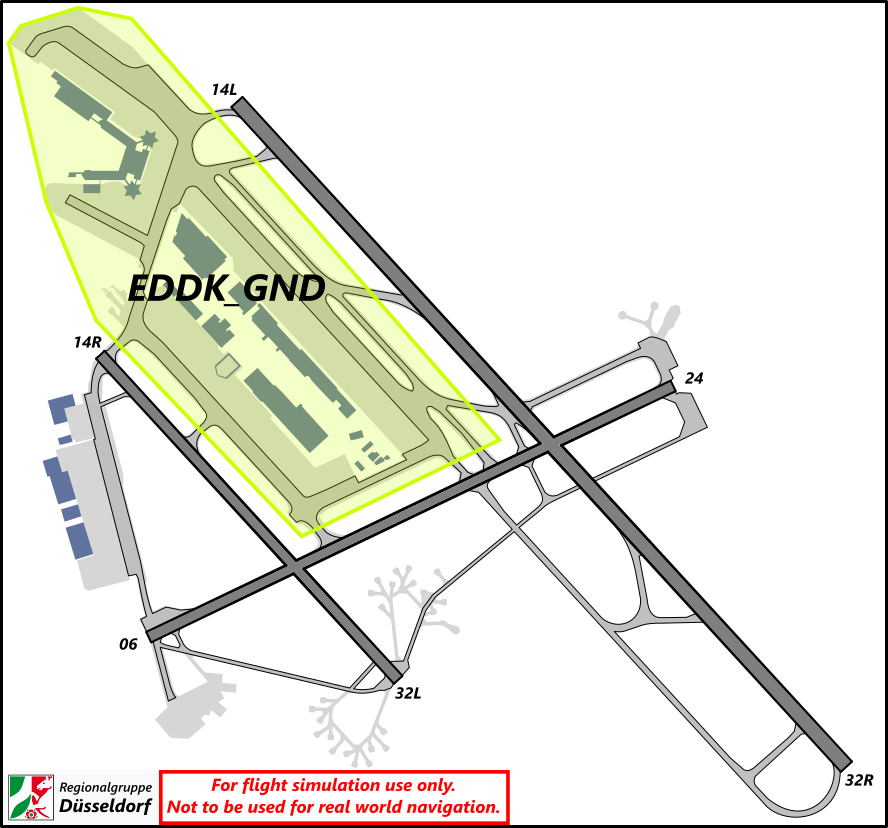](https://knowledgebase.vatsim-germany.org/uploads/images/gallery/2022-09/eddk-aor.png)Area of Responsibility - *Cologne-Bonn Ground* **Runway Crossing:** The crossing of all runways is within the responsibility of Tower, but can be delegated to Ground if the appropriate runway is not in use. ### Parking Positions Parking positions are assigned by the Ground Radar Plugin based on airline and aircrafttyp according real world usage. It is recommended to use the assigned stands. The maximum aircraft size for all parking positions can be displayed in Euroscope (Tower) with shortcut `ALT + B`. **Aprons A - D:** These aprons are the passenger terminal aprons. Aprons A-C are used for Terminal 1, while Apron D is located at Terminal 2. **Aprons E, F, V, W:** All of these aprons are home to the big cargo-city at Cologne airport. Most of the heavy lifting cargo fleet (e.g. B747), are parked on aprons E and F, while aprons Vand W are home to the small feeder fleet (e.g. B737, ATR and B757/B767). **Apron U:** Apron U is used by two maintenance companies for customers' aircraft. Parking positions U10 - U14 can be used up to code C (A321/B739) and parking positions U16 - U26 only for code A (wingspan < 15m). **Apron V:** Apron V is used for business jets and general aviation. Depending on the position, aircraft up to the size of a B737-BBJ can be parked. **GAT:** The GAT has no real permanent home. Previously it was located as shown on the map below, northeast of the RWY14R threshold. Nowaday, general aviation is parking mostly on the aprons V and U (partially civil, partially military). The original GAT as shown on the map, is home to the helipad of the Christoph 3 rescue helicopter. **Military:** Cologne/Bonn is a double purpose airport. While it mostly handles civilian aviation (either pax or cargo), it's also home to the Köln-Wahn Airbase, of the Luftwaffe. On the western part of the airport (west of 13R/31L), the so called "white fleet" (A350, 340, GLEX) is stationed. To complete the fleet stationed at EDDK, the MRTTs (Multi-Role-Tanker-Transport) A321 and A330 are also located there. **Antonov AN225 special parking procedure:** Parking parallel to taxiway A on Stands E09 to E15, main gear on E12, facing north-west. ### Taxiway Usage The primary used taxiway is A, running parallel to runway 13L/31R. [](https://knowledgebase.vatsim-germany.org/uploads/images/gallery/2022-09/eddk-twy.png)Taxiways at *Cologne-Bonn* **31-Operations:** During 31-Operations, traffic from the terminals taxiing southbound will be using TWY-A, while inbound traffic vacating the runway continues on TWY-E, to A5. If there is traffic requesting pushback on the E and F stands, outbound traffic can be rerouted via TWY-E. However, this may be blocking inbound aircraft vacating from RWY 31R. **13-Operations:** During 13-operations, inbound traffic vacating RWY 13L, heading for the terminals, will be taxiing northbound on TWY-A primarily. However, if there is traffic on aprons E and F asking for pushback, the parallel TWY-E can be used as alternative, so that the traffic on those aprons is able to push. **Runway 24/06 for taxi:** It is possible for in- and outbound traffic to use runway 06/24 for taxi. > GAF1GH, taxi to holding point runway 31R via Bravo, enter runway 06 and Alpha, cross runway 31L. > DAFHK, taxi right via runway 24 and continue T. After landing or before takeoff, the word "backtrack" has to be used. > EWG1PC, backtrack runway 24, vacate T. > RYR7AF, backtrack and lineup runway 24. ### Taxiway Restrictions Taxiway **B** and **T** can only be used up to **Code E** aircraft. Taxiway **C** is limited to **Code C** aircraft. Taxiway **D** between A and T can only be used by max. **Code E** aircraft. The part of **D** east of runway 13L/31R can also be used by a B748. **Parallel taxi on A and E with Code F aircraft:** If an Airbus **A380** is on taxiway A, taxiway E is limited to **Code D** aircraft. If a **B748** or an **AN124** is on taxiway A, taxiway E is limited to **Code E** (in case of a B748 limited to Code E + B748). **Colored lines:** In front of Terminal 2 aircraft up to code C can use the orange and blue line simultaneously up to position D51.On taxiway **B** between L and T (marked with (!)) only aircraft with a **wingspan of max. 52 m** (Code D) and max. weight of 200t are allowed to taxi on it's own. Aircraft up to 234t may be towed over or taxi on their own power over the bridge **if guided by a marshaller.**
### Potential conflicts at the ground Due to it's layout and placement of aprons, there are several critical areas at Cologne/Bonn Airport, which can either lead to congestion or taxi conflicts. **1. The holdingpoint dilemma:** The number one area marked on the map, is the area around the holdingpoint A5/A7, the northern ends of TWYs A and E, as well es TWYs B and M, around the C-Star (Terminal 1). Especially during 13-Ops, this area heavily suffers from congestion. Departing traffic will be queuing mostly at A7, some at A5, while inbound traffic will be taxiing northbound, via TWY A, B and M, to get to Apron D. Possibilities to solve at least some of the congestion issues, will be described on the following pages. **2. A3-Area**: Number two on the map, is the A3-Area. This areas is critical in different scenarios. - During 31-Operations, A3 is the first suitable highspeed-turnoff for landing traffic. Due to the speed of landing and vacating aircraft, they often fail to stop short off E and continue through to A. - Another critical situation occurs, in the case of 24-departures. 24-departures need to cross RWY 31R at A3. Whenever traffic is instructed to taxi in the direction of the A3 holdingpoint, Ground needs to coordinate with Tower and inform him about the traffic, as TWR needs to inform landing pilots, that A3 is unavailable to vacate the RWY. **3. Taxiway B-Bridge** The third critical area is placed on TWY-B. Between Taxilane-L and the GAT (marked with (!)) taxiway B leads over a bridge where only aircraft with a wingspan of max. 52 m (Codeletter D) and max. actual weight of 200 t are allowed to taxi on it's own. A332/A333 and A343 with an actual weight of up to 234 t may be towed or can taxi with a marshaller on ther own power over the bridge. **4. Taxiway D** On taxiway D only Code E aircraft and below are allowed, except the part east of runway 13L/31R where also a B748 is allowed. [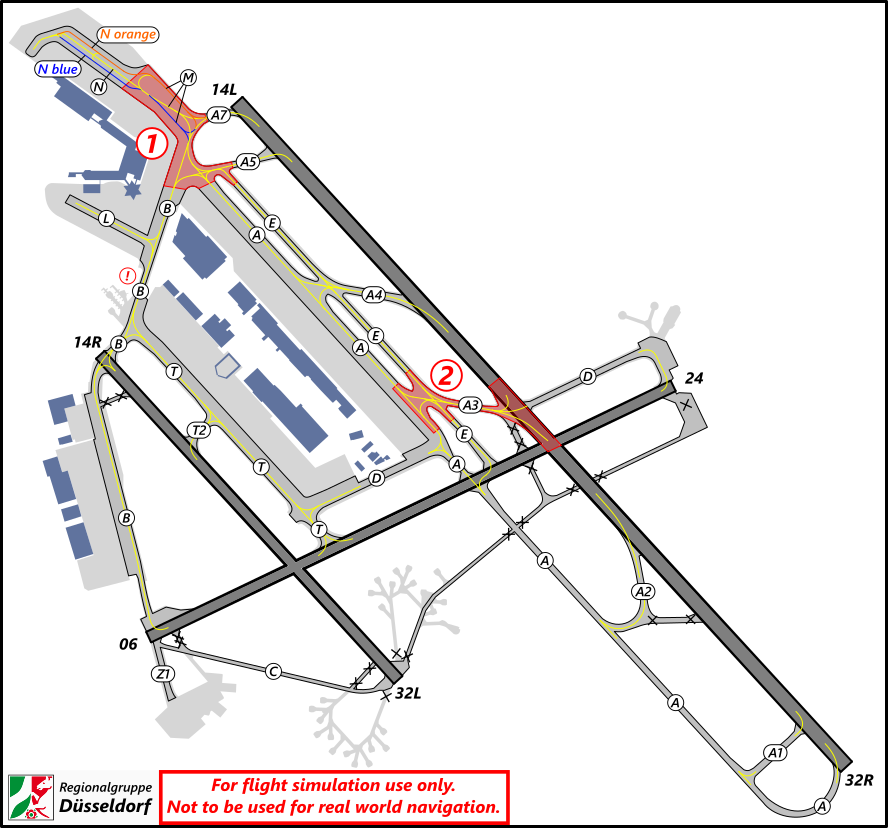](https://knowledgebase.vatsim-germany.org/uploads/images/gallery/2022-09/eddk-risk.png)*Potential conflicts on ground* ### De-Icing There are no de-icing pads available at EDDK. Every outbound has to be deiced **on position prior pushback!** In case deicing is required when the outbound is already offblock, it has to return to a position. # EDDK - TWR 2501 ### Runways The airport has three runways, two of which run parallel and one of which crosses two runways. #### Runway 13L / 31R Runway 13L/31R is the longest runway at 3815 x 60m and is primary used for all inbound and outbound traffic. Runway 31R and 13L are both equiped with ILS CAT III. #### Runway 13R / 31L At a distance of about 1km southwest of runway 13L/31R is the much shorter parallel runway 13R/31L, which is 1863 x 45m long. Due to its length and technical equipment, this runway is preferably used for VFR traffic. Because of its proximity to the military section, it is also frequently used by military aircraft. Runway 13R/31L is only approved for aircraft up to code C (e.g. B739, A321). During high traffic situations, this runway can be used for all light and medium traffic that is able (TORA 1863 m). For **non-precision approaches** to runway 13R, a flight and ground visibility of at least 2.1 km must be provided due to the shortened approach lighting. #### Runway 06 / 24 Across runways 13/31 is the intersecting runway 06/24, measuring 2459 x 45m. Only landing direction 24 is equipped with an ILS (CAT I). For RWY 06 only non-precision approaches are available. Runway 06/24 is only approved for aircraft up to code letter E, including the B748. For **non-precision approaches** to runway 24, a flight and ground visibility of at least 1.5 km must be provided due to the obstacle situation. RWY24 can be used to taxi aircraft as well. Either because of wingspan limitations on TWY D or to the military apron, as well as for aircraft landing RWY13L to vacate the runway and to avoid the sharp turn into A3. > DLH123, wind 140 degrees 4 knots, runway 13L cleared to land, runway 24 available for taxi. ### Control Zone The D-CTR of Cologne-Bonn Airport extends from the ground to 2500ft MSL. [](https://knowledgebase.vatsim-germany.org/uploads/images/gallery/2022-10/eddk-ctr.png) *Controlzone Cologne-Bonn (D-CTR) - © [openflightmaps.org](https://www.openflightmaps.org/)* **Airfields:** South of the control zone lies the airfield Bonn-Hangelar EDKB, which, including its traffic circuit, is located outside the control zone. To the north, also outside the control zone, is Leverkusen EDKL airfield. Its traffic circuit, however, extends into the control zone at an altitude of 1100ft on its southern side. Please note the following: "From SR-30 until SS+30, the control zone in the depicted Dünnwald sector is not active. The general airspace classifications G (up to 1000ft AGL) and E (above 1000ft AGL) apply." (Source: [*AIP VFR Germany VOC EDKL*](https://aip.dfs.de/BasicVFR/pages/P0034A.html)) **Hospitals:** Several hospitals with helipads are located in the urban area of Cologne. In the extended centerline of runway 13L, approx. 1.5 km north of the NDB LJ, is the hospital Merheim. Approaches to runway 13L fly over the hospital at approx. 1500ft. Helicopters may approach the landing area below the approaching traffic. Appropriate traffic information must then be provided to avoid missed approaches. On the north-western edge of the control zone in Cologne-Nippes, on the CTR boundary, is the rather seldom approached St. Vinzenz Hospital. On the west side in the Lindenthal district, just outside the control zone, is the University Hospital of Cologne. To the west of the control zone is the Nörvenich ETNN airbase. Despite their proximity, the control zones of the two airports do not border directly on each other, but are separated by a narrow strip of type C airspace. ### VFR-Traffic There are 7 mandatory reporting points and 1 optional reporting point available for VFR traffic at Cologne.| **Reporting Point** | **Location** |
| **NOVEMBER 1** | BAB 4, exit Bergisch Gladbach-Bensberg |
| **NOVEMBER 2** | BAB 3, motorway service station Königsforst-Ost |
| **ECHO 1** | Church in the middle of Neunkirchen |
| **ECHO 2** *(Optional)* | BAB 3, service area Sülztal |
| **SIERRA 1** | Marina at the mouth of the Sieg River into the Rhine |
| **SIERRA 2** | Sports facilities north of the village of Troisdorf-Spich |
| **KILO 1** | BAB 1 / BAB 57, motorway interchange Köln-Nord |
| **KILO 2** | BAB 4, rhine bridge Rodenkirchen |
Targetspacing for inbounds only need to be applied by Arrival when **requested by Tower!** Otherwise radar or WTC seperation is used by default.
Note: In order to maintain seperation Köln Tower may reduce aircraft after transfer of communication. While not neccesary, it is recommended to only use speed control after prior coordination with the Arrival Controller.
### RECAT-EU procedures According to new wake turbulence minimum separation values established by Eurocontrol, the familiar categories established by the ICAO (Light, Medium, Heavy, Super) have been divided into new sub-categories, thus offering the possibility of separating aircraft in certain categories even more closely. The DFS has decided to apply the procedure at Cologne Bonn, but only in the “Lower Heavy/Lower Heavy” category and restricted to aircraft types A300, B757 and B767. This means that two consecutive aircraft **(WTC H)** can be seperated by 3 miles and do not have to be seperated by 4 miles, as required by ICAO guidelines, if the preceeding aircraft is one of the of the above-mentioned aircraft type. For further information: [RECAT-EU](https://www.eurocontrol.int/publication/european-wake-turbulence-categorisation-and-separation-minima-approach-and-departure) ### Missed Approaches For all published approaches, missed approaches will be executed as published unless otherwise coordinated. EDDK Tower has to ensure initial separation between departures and between departures and missed approaches. He therefore may take action to ensure or reestablish seperation. Radar shall be informed immediately of the action taken. Transfer of Communication then takes place, once seperation is established. Missed Approaches should be tranfered to Feeder (DKAT), if not otherwhise coordinated. The next departure requires a departure release. ### Crossing Runway Operations Combined operation of runways 13L/31R and 24 has the highest capacity. When runway 13R/31L is used as well, runway 24 is blocked for significantly longer. It is important during crossing runway operations that the preceeding traffic (landing or departing) has crossed the runway cross before the succeeding traffic (landing) for the other runway has reached the 1 NM final. Otherwise the succeeding traffic has to go around.**Example:** Departing traffic runway 31R has passed the runway cross before the inbound reaches 1 NM final for runway 24.
### Nörvenich sector A If the military approach sector for Nörvenich (ETNN) has activated sector A, **NVO SID´s out of runways 24 and 31, as well as COL departures out of runway 24 may no longer depart. Coordination with DKA required.** Usually, this sector will only be active for short periods of time to allow TNNA to vector arriving traffic to final approach during 24 operations at ETNN; however, when there is local IFR traffic at ETNN, the sector may be activated for longer periods. After coordination with DKA NVO outbounds should be recleared to runway 13 or, on a different SID (e.g. COL/WYP) to expect vectors to NVO after departure. **DKA** (or TNNA, if DKA is offline) **will inform Tower when sector A is activated and deactivated**. ### Transfer of Communication "Auto Handoff": Köln/Bonn utilizes an auto-handoff procedure for IFR departures where **Tower will not hand off outbounds to the arrival controller**. Make sure to set the correct departure frequency in the ATIS.Outbounds should contact APP **when passing 2.000 ft MSL** unless explicitly told to remain on Tower frequency.
# EDDK - Arrival 2501 The area around Cologne is divided into four sub-sectors. In addition to the Approach and Arrival stations, sector NOR handles the lower airspace west and above Cologne up to Maastricht/Rhein Radar. NOR is the primary station and covers all other Sectors top-down. If only DKA is staffed, this sector will not cover NOR.DKA frequency shall always be cross-coupled by the responsible controller.
Please also **check the [ETNN TWR/APP](https://knowledgebase.vatsim-germany.org/books/sops-fir-langen/chapter/etnn-norvenich-airbase) and [EDDK Tower, Ground, and Delivery](https://knowledgebase.vatsim-germany.org/books/sops-fir-langen/chapter/eddk-kolnbonn-airport) SOPs** to familiarize yourself with relevant procedures for Arrival operations and to enable the necessary coordination with the ground stations.
## Sectorization and Airspace ### Cologne Approach (DKA) Approach is responsible for the area around Cologne/Bonn Airport up to the Belgian border. The sector handles all departures from Cologne and presequences all inbound flights for the feeder. If arrivals or departures from Nörvenich (ETNN) take place without Nörvenich Radar (TNNA) being staffed, this traffic is also handled by Approach.| [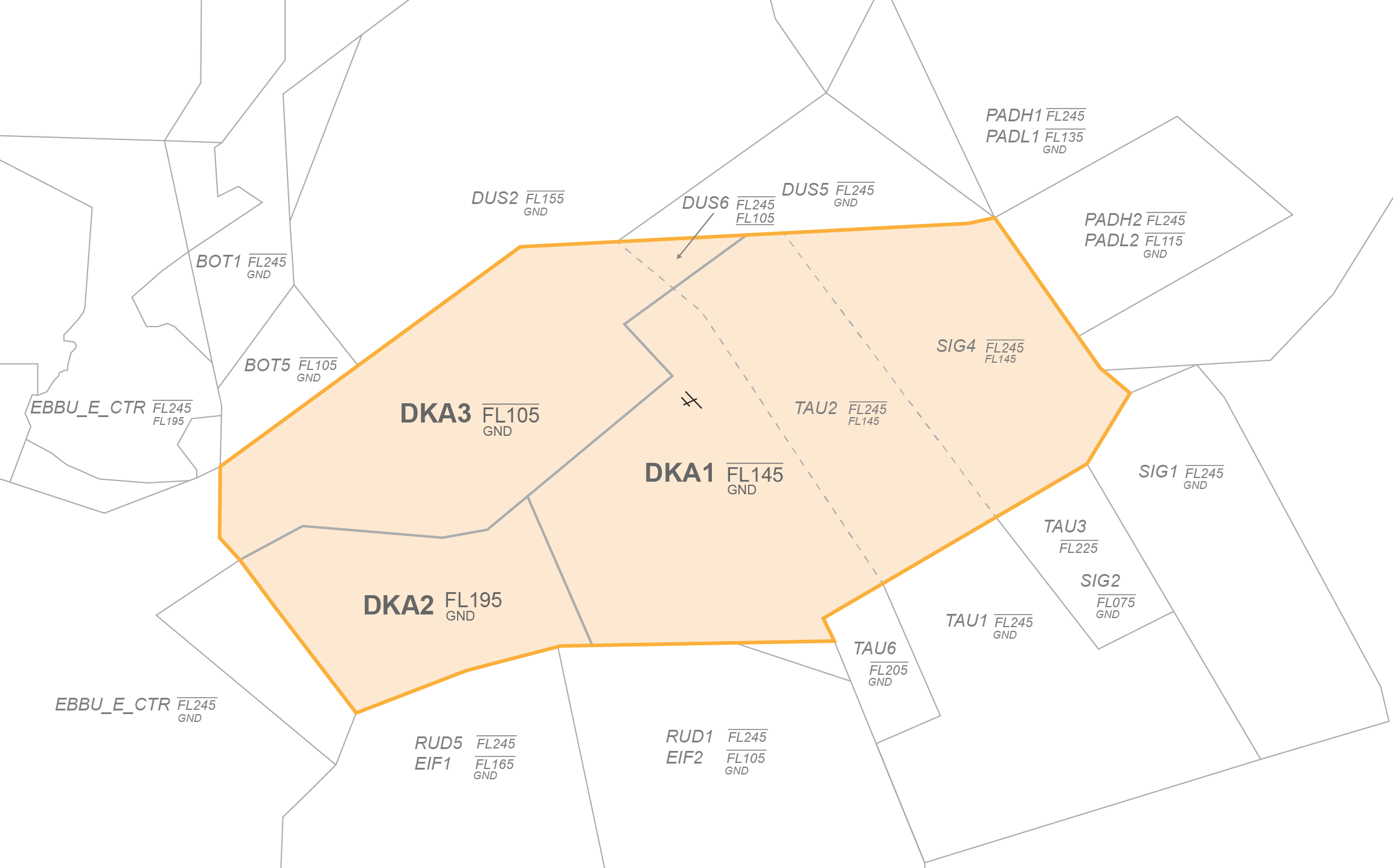](https://knowledgebase.vatsim-germany.org/uploads/images/gallery/2025-01/ozxdka-sector-at-2x-cropped.png) |
| *Area of Responsibility Arrival* |
| [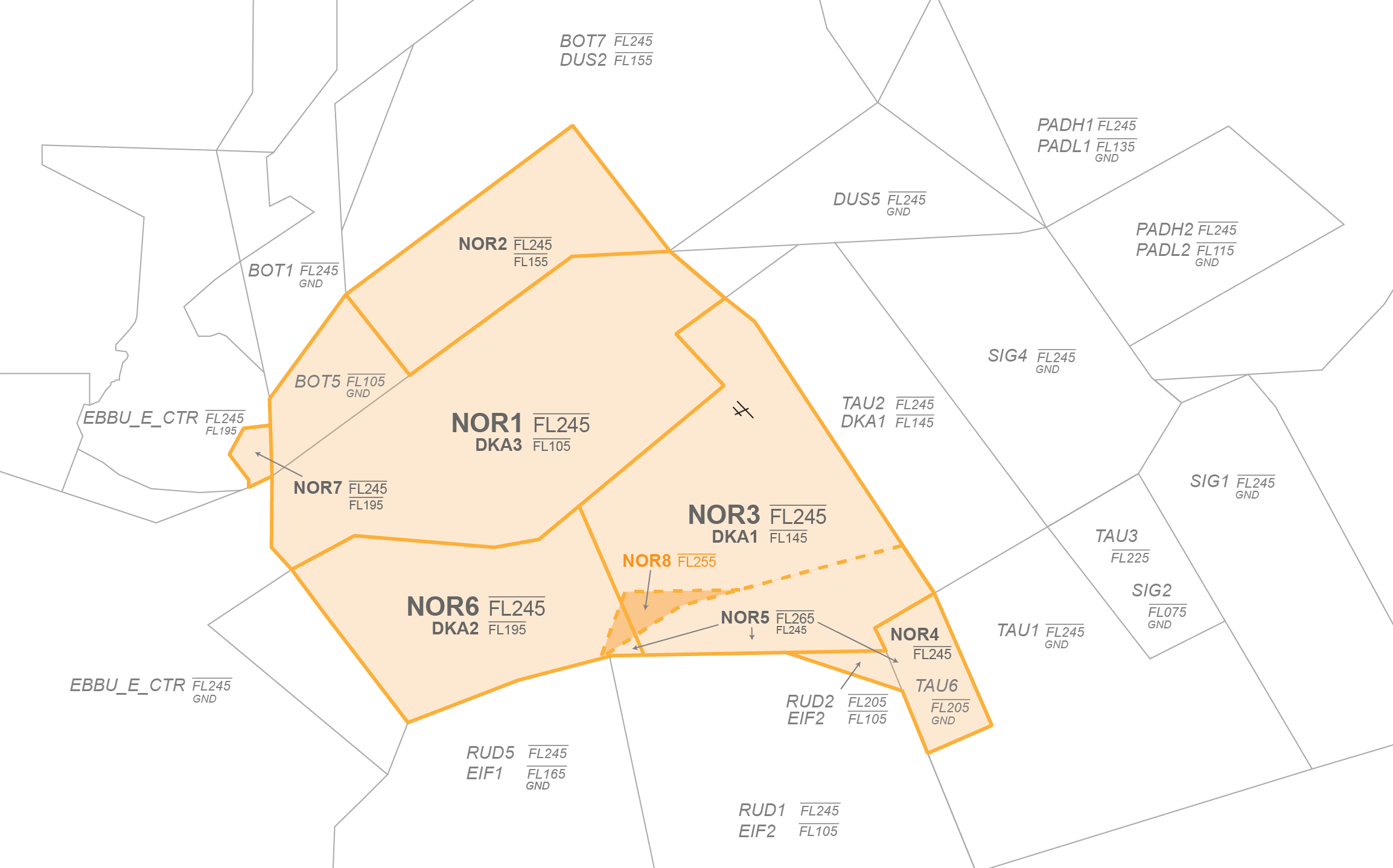](https://knowledgebase.vatsim-germany.org/uploads/images/gallery/2025-01/jZhnor-at-2x-cropped.png) |
| *Area of Responsibility Sector Nörvenich* |
| [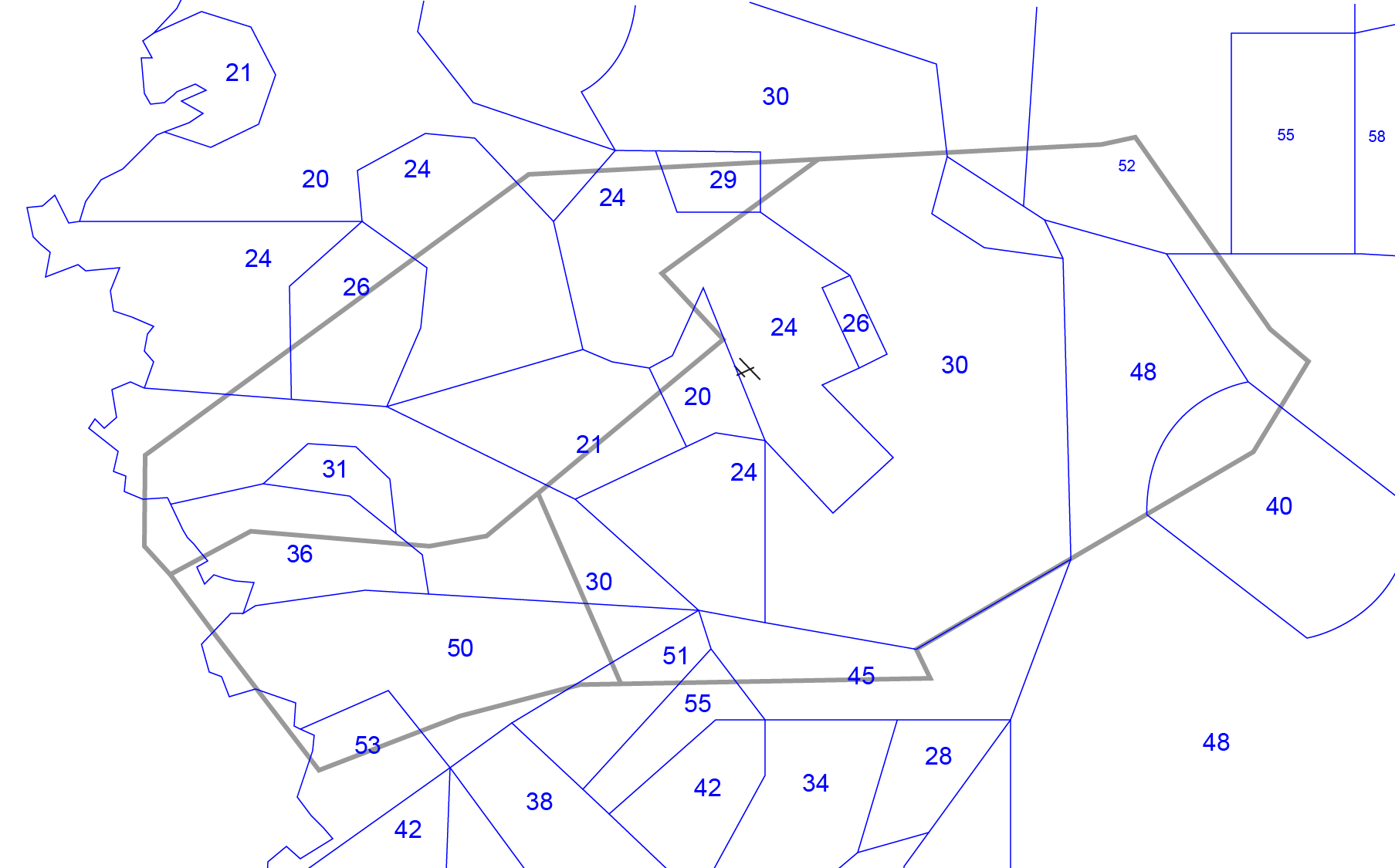](https://knowledgebase.vatsim-germany.org/uploads/images/gallery/2025-01/eddk-app-winter-mva.png) | [](https://knowledgebase.vatsim-germany.org/uploads/images/gallery/2025-01/eddk-app-summer-mva.png) |
| *EDDK Winter MVA* | *EDDK Summer MVA* |
Targetspacing for inbounds only need to be applied by Arrival when **requested by Tower!** Otherwise radar or WTC seperation is used by default.
Note: In order to maintain seperation Köln Tower may reduce aircraft after transfer of communication without any prior notification.
#### RECAT-EU Procedures According to new wake turbulence minimum separation values established by Eurocontrol, the familiar categories established by the ICAO (Light, Medium, Heavy, Super) have been divided into new sub-categories, thus offering the possibility of separating aircraft in certain categories even more closely. The DFS has decided to apply the procedure at Cologne Bonn, but only in the “Lower Heavy/Lower Heavy” category and restricted to aircraft types A300, B757 and B767. This means that two consecutive aircraft **(WTC H)** can be seperated by 3 miles and do not have to be seperated by 4 miles, as required by ICAO guidelines, if the preceeding aircraft is one of the of the above-mentioned aircraft type. For further information: [RECAT-EU](https://www.eurocontrol.int/publication/european-wake-turbulence-categorisation-and-separation-minima-approach-and-departure)This Procedure is limited to the lateral and vertical sector limits of DKA and only applicable at or below FL100.
#### Missed Approaches For all published approaches, missed approaches will be executed as published, unless otherwise coordinated. Tower has to ensure initial separation between departures and between departures and missed approaches. He therefore may take action to ensure or reestablish seperation. Radar shall be informed immediately of the action taken. Transfer of Communication then takes place, once seperation is established. Missed Approaches should be tranfered to Feeder (DKAT), if not otherwhise coordinated. The next departure requires a departure release. #### High Rate of Inbound Traffic **DLA Agreement:** During high traffic situations at EDDK with 13 operations and low traffic at EDDL, DKA can request a general airspace crossing to vector inbounds 13L/R through the DLA sector. Traffic need to stay at 5.000ft or below within AoR of DLA and at least 3 NM south of the extended centerline RWY 05R. Further individual coordination for level and extension possible when required. The use of this crossing may be withdrawn, depending on the amount of departing southbound traffic in EDDL. Prior notification should be given around 10-15 minutes before withdrawal by DLA. **TAU/EIF Agreement:** To use the sectors of EIF or TAU individual coordination required. ### Crossing Runway Operations It is important during crossing runway operations that the preceeding traffic (landing or departing) has crossed the runway cross before the succeeding traffic (landing) for the other runway has reached the 1 NM final. Otherwise the succeeding traffic has to go around. Arrival/Feeder has to ensure, that traffic cleared on the approach of crossing runways is separated in a way, that the preceeding traffic has passed the runway crossing point, before the succeeding traffic reached it's 1 NM final. Therefore it is necessary, that both aircraft are cleared on the approach, with at least 2 NM separation between each other. Especially factors like headwind and aircraft performance has to be taken into account. **Runway 13L/31R + Runway 24 Operations:** Due to the shorter distance from the **FAF** (Final Approach Fix) to the crossing point between RWY13L/31R and RWY 06/24, arrivals on **RWY 24** shall be cleared as the preceeding aircraft whenever possible. # EDDK - High Traffic Procedures ### Runway allocation **Outbound 13 operation:** All outbounds with WTC Light and Medium are assigned runway 13R for departure. The 1863 m runway should be sufficient for most outbounds. If the pilot reports unable, he will be assigned runway 13L like all Heavies.ATIS Code "**&eddk13r**" shall be used: ALL DEPARTING LIGHT AND MEDIUM TRAFFIC EXPECT RWY 13R FOR DEPARTURE. REPORT UNABLE ON INITIAL CONTACT.
**Inbounds 13 operation:** Primary use of runway 13L for all inbounds, runway 24 should not be used. **Outbound 31 operation:** All outbounds are assigned runway 31R. **Inbounds 31 operation:** All inbounds with WTC Light and Medium are assigned runway 24. Inbounds Code D (B767/A306) should be asked if possible whether they can accept runway 24. All others will be given runway 31R. **Start-up:** A maximum of two or three Heavies should be started up at the same time for 13L. ### Seperation and Spacing Target spacing on runway 24 is 4 NM or WTC staggering if necessary (note staggering to inbounds runway 31R!). Target spacing for runway 13L/31R of 6 NM by touchdown must be explicitly requested by the tower. ### Holdings Primarily, only the holdings at **GULKO** and **KOPAG** in the centre's area of responsibility should be used. The holding via NVO should not be used due to the outbounds via NVO, **ERUKI** holding should be used instead. Which holding is used for inbounds via ERNEP (GULKO or KOPAG) must be coordinated individually depending on the traffic situation (incl. transfer level). To relieve DKA, PADH and GIN, the TAU/SIG sector combination can be used to manage the holdings. For KOPAG holdings above FL140, the transfer from PADH to SIG takes place at individually coordinated levels. If holds in the APP area are required at short notice, only WYP (13L) and COL (31R, 24) are to be used, as otherwise there will be conflicts with outbounds. If only inbounds need to be delayed on the 31R, the COL holding in the APP area should be used for this. Every 3 minutes (or every 6 minutes per ‘holding waypoint’), one aircraft from the KOPAG, GULKO or ERUKI holding can leave the holding (one orbit takes about 4 minutes). It should be noted that NVO/DEPOK inbounds are not prioritised and the delay is evenly distributed. Depending on the situation on the ground, the worst inbound rate is 12 inbounds per 30 minutes! The inbounds are sent from the centre to WYP (13) or COL (31 and 24) at the normal transfer level to clear the holding. Individual arrangements are possible at any time. **Inbounds 0 - 11:** no holds expected **Inbounds 12 - 17:** consider outbounds, from 12 outbounds in 30 minutes, holds not excluded **Inbounds 18 - 24:** take outbounds into account, from 6 outbounds in 30 minutes, holds likely **Inbounds more than 24:** Inbounds exceed the maximum capacity even without outbounds, holdings unavoidable.